May 31, 2012
Staatsoper Unter den Linden: Another Setback
By Frank Cadenhead [Opera Today, 31 May 2012]
The re-opening of Berlin State Opera Unter den Linden has been set back for another year. This is on the heels of a previously announced one year delay. The refurbishing was originally supposed to be finished by October of next year and now the theater is scheduled to open in the Fall of 2015.
More Delays for the Berlin State Opera
This is on the heels of a previously announced one year delay. The refurbishing was originally supposed to be finished by October of next year and now the theater is scheduled to open in the Fall of 2015.
Problems resulted from the discovery of remains of Middle Age lake dwellings, wooden stilt houses, under the theater. The main cause of the delays, however, are the new plans to increase the insulation the building from the underground water. The floor of an underground passage between the rehearsal facility and the hall, for example, was to have some five feet of concrete but new plans call a doubling of that.
Both music director Daniel Barenboim and director Jürgen Flimm expressed their displeasure with the news of the delay. Since September 2010, the opera has been temporarily housed in Berlin's Schiller Theater.
Frank Cadenhead
image=http://www.operatoday.com/Staatsoper_Unter_den_Linden.gif image_description=Staatsoper Unter den Linden product=yes product_title=More Delays for the Berlin State Opera product_by=By Frank Cadenhead product_id=Above: Staatsoper Unter den LindenTristan und Isolde, Welsh National Opera
A work the size of Tristan und Isolde is something of a challenge for a touring company like WNO and this production will only be played in Cardiff (19/5, 26/5, 2/6) and Birmingham (16/6) with a concert version at the Edinburgh Festival.
The production has worn well and Kokkos’s sets still look very handsome. Kokkos provides a fixed structure of a frame with a frame, and within this uses semi-abstract sets to evoke the ship in act 1, the forest in act 2 and the rocks of Kareol in act 3, in generally cool grey tones. In doing so he gives himself a fluid and flexible acting area. Costumes are timeless, evoking medieval but with quite a heavy reliance on that old stand-by, the great coat. The results mean that the women looked elegant and the men suitably heroic.
Kokkos has not specific axe to grind in the production, no psychological idée fixe and he seems content to tell the story with clarity, and certainly no dramatic additions such as Brangäne’s liaison with Kurwenal during act 2 (in the recent Covent Garden production).
In act 1, Tristan (Ben Heppner) and Kurwenal (Phillip Joll) are on the upper level, behind a scrim, with the the action of the ship evoked in a series of tableaux, whilst at the front Isolde (Ann Petersen) and Brangäne (Susan Bickley) are at the front on the lower level, separated physically and emotionally from the men. In act 2, the forest forms the back-drop for the long sweep of stairs on which the lovers’ meeting takes place. This is not a production where Tristan and Isolde never touch; Kokkos arranges the love-duet into a series of static scenes where the lovers intertwine. For act 3 the set is reduced to a single, huge slab sloping down the stage, resting at the rear on the rocks from which the Shepherd (Simon Crosby Buttle) keeps look-out.
Within this, there was a lot of scope for drama, this opera essentially relying on the interactions between the principals. Here the revival director does not seem to have been able to engender a real dramatic spark between Heppner and Petersen. In act 1, Petersen delivered Isolde’s curse with brilliant vehemence and gleaming tone, but in her scene with Heppner’s Tristan, the two seemed just a little too polite with each other. We relied on the music to transport us. The same happened in act 2, where non action of the love duet very much relied upon the music to give it dramatic impulse. In their solo moments both Heppner and Petersen proved acute, so it was a shame that the two did not develop their relationship more.
Petersen is a young Danish soprano who is developing as a dramatic soprano. Recent engagements have included her first Leonore and Marschallin, along with Elsa, Elizabeth and Ariadne. She has further Isoldes lined up plus Senta, the Empress (Die Frau ohne Schatten) and Sieglinde. That her progress to more dramatic roles is being carefully considered is confirmed by the way she sang Isolde with a voice of great lyric beauty. Her voice rode the orchestra at the crucial points, but she did not force the tone. Conductor Lothar Koenigs seemed to be a sympathetic partner, not pushing the orchestra towards drowning the soprano.
Petersen had a good feel for the text; her coloration of the words was always notable. This was a dramatic performance, certainly not one where the voice was content to coast over Wagner’s luxuriant orchestration. Physically as well, Petersen is an apt performer, ensuring that the unspoken/unsung moments of drama tell for as much as the spoken ones. She was at her best in this in act 1, where there is much that an acute Isolde like Petersen can do to develop the drama.
She was a strong and equal partner to Heppner in the love duet, each egging the other on musically towards the ultimate coitus interruptus of the climax. Here her performance was less dramatic, and you sensed a desire to allow the music space. Though, as I have said, I feel more could have been made of this scene.
Her account of the Liebestod was beautifully rapturous. At all times she preserved the beauty of tone and moulded Wagner’s phrases intelligently. Kokkos phased out the drama during this scene, gradually focusing attention on the single figure of the transfigured Isolde to close the action.
Having been through a difficult period with his voice, attention inevitably focused on Ben Heppner’s Tristan. I had missed hearing him in London when he cancelled due to illness, so was pleased to catch up with him in the role in Cardiff. Heppner remains a hugely vivid and dramatic performer, one who can be intensely expressive notwithstanding his bulk. His size meant that, inevitably, Tristan had a substantial and heroic presence from the start. His voice has lost its burnished beauty of tone, but retains a massive, granite-like grandeur. The feeling that Heppner was hewing the tenor part out of rock contributed immensely to his performance. Heppner’s Tristan was a warrior who had suffered and would continue to do so, achieving even the rapture of the love duet with difficulty.
His voice took time to warm up and I was worried at first that he might have tuning problems. But things settled down to a feeling of rough-hewn grandeur. In the quieter moments, particularly in the opening of the love duet, Heppner achieved a beauty of tone which matched that of Petersen. Though at the top of his voice there was a certain tightness, a lack of freedom at times. It has to be admitted that he noticeably tired during the performance, with odd notes failing to register properly. But in act 3, he was simply astonishing, achieving a degree of dramatic transfiguration that I would not have believed. Here was a massive character, really suffering.
Susan Bickley’s warm and intensely dramatic Brangäne was one of the strong points of act 1. She formed a strong and believable link with Petersen’s Isolde and Bickley’s vivid performance helped anchor the drama. As a singer, Bickley never ceases to amaze me, she has a wide repertoire and a knack of making a role her own, whether the composer is Handel, Berlioz, Wagner or George Benjamin. Strong Brangänes cannot make a performance of this opera, but with principals as strong as Petersen and Heppner, Bickley was able to contribute to the powerful ensemble feeling of the opera.
Phillip Joll’s Kurwenal was a bluff, old soldier figure; warm and sympathetic with intense regard for Tristan. He provided rock-like support for Heppner’s dramatic power in act 3.
Matthew Best was a committed and intense King Marke. He is one of the best around today and deserved every moment of the long applause he received at the end. But I have to confess that I generally find King Marke a prosy bore and that Best did not quite convince me otherwise. Marke’s long solo at the end of act 2 requires a very, very special touch to pull one’s attention off the love duet. Though Best acquitted himself intelligently, he did not quite manage to pull focus the way he should.
Simon Thorpe was dramatically committed in the role of Melot, Simon Crosby Buttle was nicely mellifluous both as the sailor and the shepherd, with Julian Boyce as the Helmsman.
Lothar Koenigs conducted with sympathy and a good ear for accompanying the singers. He has clearly developed a good relationship with the orchestra and drew a strong performance from them with some good individual solo playing. Koenigs speeds were on the moderate to fast side, but the music never felt rushed. He seemed content to let the drama flow. There weren’t the slow speeds and architectonic feel you get with some conductors, which can be a distinct advantage when it comes to running time.
Any performance of Tristan und Isolde is a landmark and this was anything but a routine revival. The combination of Heppner’s heroic, rough-hewn Tristan with Petersen’s mellifluously intelligent Isolde and Koenigs’ sympathetic accompanying ensured a memorable evening, even if dramatic sparks did not quite fly the way I would have liked.
To a certain extent the virtues of Kokkos’s production are negative, in that it does not get in the way of the music and Kokkos does not try to re-make the work in his own image. But where a company can afford to revive Tristan und Isolde only rarely, and when many of the audience may be seeing it for the first time, this clarity of style can become a positive virtue.
Robert Hugill
image=http://www.operatoday.com/WNO-Tristan-and-Isolde-2012.gif image_description=Ben Heppner as Tristan and Ann Petersen as Isolde [Photo by David Massey courtesy of Welsh National Opera] product=yes product_title=Richard Wagner: Tristan und Isolde product_by=Sailor: Simon Crosby Buttle; Helmsman: Julian Boyce; Isolde: Ann Petersen; Brangäne: Susan Bickley; Kurwenal: Phillip Joll; Tristan: Ben Heppner; Melot: Simon Thorpe; King Marke: Matthew Best; Shepherd: Simon Crosby Buttle. Conductor: Lothar Koenigs. Director and Designer: Yannis Kokkos. Revival Director: Peter Watson. Choir and Orchestra of Welsh National Opera. Wales Millenium Centre, Cardiff, 19th May 2012. product_id=Above: Ben Heppner as Tristan and Ann Petersen as Isolde [Photo by David Massey courtesy of Welsh National Opera]May 30, 2012
“Balanced Budget” in Chicago
By Frank Cadenhead [Opera Today, 30 May 2012]
The Lyric Opera of Chicago announced their financial figures in their annual report and “balanced its budget” for the 2011-2012 season, according to general director Anthony Freud. Additionally, the company’s music director, Sir Andrew Davis, has had his contract extended for six more seasons.
Lyric Opera Posts Annual Report
Additionally, the company’s music director, Sir Andrew Davis, has had his contract extended for six more seasons.
In almost every category, the numbers showed small increases and suggest continued stability for the company. Ticket revenue was $25 million, a $1.3 million increase from last year. Fundraising goals were also surpassed, with $21.1 million contributed, some $3 million more than the year previously. Tickets sold were 233,113, about 3,550 more than last year, with a healthy average capacity of 88%
The “balanced budget” declaration might leave some, who define a balanced budget as income matching expenses, scratching their heads. The total budget was $57.4 million but the company’s revenue was not enough to match this and $3.8 million was taken from the company’s reserve fund to make the difference. This dipping into reserves has been a feature of the annual report for the past few years. It is less than last year’s $4.3 million but nevertheless an important figure.
Music director Sir Andrew Davis’ contract, set to expire with the 2014-15 season, has been extended for six additional seasons. Freud declared that “his ongoing commitment to our company is of fundamental importance to Lyric’s strength and success.”
Frank Cadenhead
image=http://www.operatoday.com/Andrew_Davis.gif image_description=Sir Andrew Davis product=yes product_title=Lyric Opera Posts Annual Report product_by=By Frank Cadenhead product_id=Above: Sir Andrew DavisA Tempest in Vienna
By Frank Cadenhead [Opera Today, 30 May 2012]
Conflicts like this usually remain inside opera house walls. The three Viennese daily newspapers carried headlines reporting that Oscar-winning director William Friedkin called the intendant of the Theater an der Wien a “liar.”
Thunder Storm at the Theater an der Wien
He was reacting to comments of Roland Geyer, chief of Vienna’s second opera, who, in July, is returning the Friedkin production of Jacques Offenbach’s Les contes d’Hoffmann to his Theater an der Wien for a second run. Geyer maintained that this revival, with important changes, was known to Friedkin. Geyer also explained that these modifications to the production made him the new stage director.
Geyer explained last week that he had added some material and made some cuts to the opera resulting in a new staging shorter by “almost half an hour.” Friedkin suggested that this was like a “dog peeing on a tree” and claiming ownership. He also asserts that he was never told of the Theater’s dissatisfaction with the March production and had intended to return to Vienna to direct a new cast.
The performing version used at the Theater an der Wien was based on the recent integral edition of the opera, considered by many to be definitive, edited by Michael Kaye and Jean-Christophe Keck. Kaye supported Friedkin’s work in this production. This edition, including material the composer was working on when he died, ran three and a half hours (with one intermission) in March.
Frank Cadenhead
image=http://www.operatoday.com/william_friedkin.gif image_description=William Friedkin product=yes product_title=Thunder Storm at the Theater an der Wien product_by=By Frank Cadenhead product_id=Above: William FriedkinGlyndebourne Janáček The Cunning Little Vixen
Inspired by a novella illustrated by cartoons, the story of Vixen Sharp Ears has great charm. The production glows with gorgeous colours, on stage and in the pit. Vladimir Jurowski conducts the London Philharmonic Orchestra with lustrous style: you can hear the “birds” in the score, feel the sunshine and thrill to the starlit night sky in the final scene.
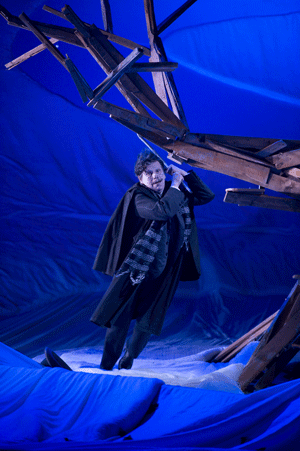 Adrian Thompson as The Schoolmaster
Adrian Thompson as The Schoolmaster
The Cunning Little Vixen is about nature, but it’s not naturalistic. Janáček observed nature closely, but doesn’t write about animals so much as about human nature. Thus the intense gemstone colours of Tom Pye’s designs dazzle gloriously. Like the World Ash Tree in Wagner’s Ring, a huge construction looms over the stage. It’s a tree which changes with the seasons : spring blossom, autumn golds, bare winter branches. Since one of the themes in this opera is the passing of time, the tree is a natural metaphor. There’s a slide behind it from which animals pop up and observe. Later, it’s shown as the lair in which the foxes live. This vividness reflects Jurowski’s approach to the music. Although Jurowski softens the sharper edges of Janáček’s idiom, he creates surges so lush that he brings out the vigorous life force that’s fundamental to the meaning of this opera. The Vixen dies, the Forester grows old, but nature renews itself each year, and the grandchildren of foxes and frogs continue the cycle of life.
“Kontrapunkte, Kontrapunkte”, the Forester (Sergei Leiferkus) tells the Schoolmaster (Adrian Thompson) He’s explaining that the dry old schoolmaster’s not right for a woman like Terinka. It’s a wry joke, not something a woodsman would say, but a composer might. Perhaps Janáček identified with the Schoolmaster, withering away without love. Significantly, he found new creative momentum in old age, when he met Camila Stösslová. Janáček is quite explicit about what makes the sap rise in human beings. “How many children do we have, dear?” asks the Fox of the Vixen. “We’ll make many more”.
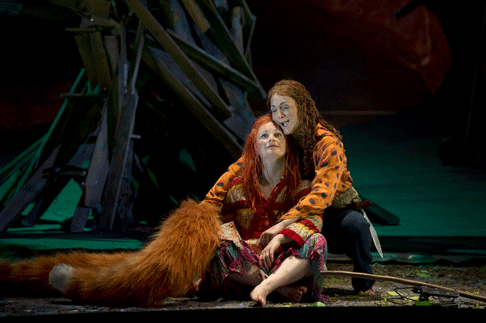 Lucy Crowe as Vixen Sharp Ears and Emma Bell as Fox
Lucy Crowe as Vixen Sharp Ears and Emma Bell as Fox
In this production, one of the finest scenes is the one where the Fox (Emma Bell) courts the Vixen (Lucy Crowe), just as a formal, old-fashioned formal couple might have done in Janáček’s youth. “May I call upon you?” he asks, and she responds coyly. Very decorous. Animals don’t beat around the bush like that. Janáček then becomes even more daring. “Do you smoke?” asks the Fox. Is the Vixen A Modern Woman, emacipated like Stösslová, and not domesticated like Zdenka, the composer’s wife? The Vixen lives independently (in a treehouse inherited from “Uncle Badger” (Mischa Schelomianski). “My ideal woman!” cries the Fox. There are cryptic personal meanings in The Cunning Little Vixen which can easily be missed. Please see my piece “Janáček, Cunning Vixen and Subversion”. The scene isn’t heavily scored, so the words carry weight and Jurowski lets them be heard clearly, Then, when the mood shifts, orchestral textures become more dense, even sinister. Listen for the triumphant finale, which could be sheer Hollywood (though it was written long before film had sound). As life ebbs from the Forester’s body, his spirit breaks free. You can imagine Janáček joyfully defying convention. The Forester doesn’t die with “The Old Woman”, his wife (Jean Rigby) but with the spirit of the Vixen and her wild ways.
Sergei Leiferkus’s Forester is outstanding, created with real vigour. He’s of course an extremely experienced singer, but he’s also a strong actor with a wonderful sense of humour. He does Shostakovich satires with panache. In 2010, he sang Edward German’s Who were the Yeomen of England at the reconstruction of a 1910 Prom. He sang with a heavy accent, but with such glee that it felt more sincere than any dour, irony-free performance. Adrian Thomnpson, as the Schoolmaster/Mosquito, was sadly underused. He can sing Czech better than most Englishmen, and has done a lot of Janáček. He deserves a higher profile. Lucy Crowe as The Vixen was clear. pert and spirited, as a good Vixen should be.
This Glyndebourne Cunning Little Vixen is great entertainment, and orchestrally rewarding. It’s let down, however, by direction that’s less incisive. While Janáček defines the roles vividly, Melly Still turns characters into caricatures. Dressing humans as animals is almost as tricky as dressing animals as humans. From time to time, the cast move like animals, but that’s not enough. The focus should be on who the animals really represent. Partly the problem lies in the costumes (Dinah Collin) which make it hard to realise who’s who unless you’ve read the synopsis.
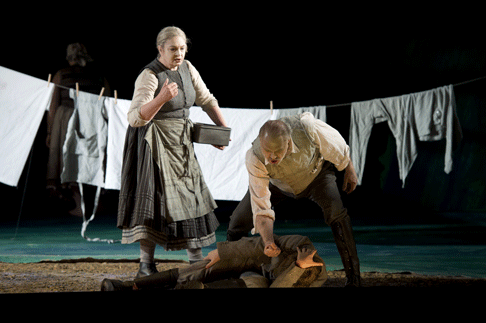 Sergei Leiferkus as The Forester and Jean Rigby as his wife
Sergei Leiferkus as The Forester and Jean Rigby as his wife
But the bigger problem is that the parts are given no personality. The weakest scene in this production occurs in the hen coop where the Vixen tries to get the chickens to rebel against male dominance. It can be literally “red of claw and tooth” because the Vixen tears the Cock apart. Here, though, it’s so tame you could miss it among the busy babble going round the stage. The dancers are nice, but they don’t add much. Yet the Cock, Hens and The Dog are all crucial to the deeper meaning of this opera. Even the Vixen isn’t well developed. When the Vixen discovers the mystery of sex, poor Lucy Crowe pushes up her blouse in an unsubtle attempt to look “sexy”. Yet what Janáček has been telling us all along is that nature is instinct, not appearance, and that instincts win. When these darker, more radical aspects of the opera aren’t defined, The Cunning Little Vixen loses its bite. And what is a Vixen without fangs?
This production will be broadcast online on 10th June. On film, it might be a better experience. A film director could focus on essentials, and give the characters more definition than the stage director.
For more details, please visit the Glyndebourne website.
Anne Ozorio
image=http://www.operatoday.com/vixen11_bill_cooper.gif
image_description=Lucy Crowe as Vixen Sharp Ears. [Photo by Bill Cooper courtesy of Glyndebourne Festival 2012]
product=yes
product_title=Leoš Janáček: The Cunning Little Vixen
product_by=Forester: Sergei Leiferkus; Vixen (Bystrouška): Lucy Crowe; Fox: Emma Bell; Parson / Badger: Mischa Schelomianski; Harašta, a poacher: William Dazeley; Forester's Wife / Owl: Jean Rigby: Schoolmaster / Mosquito: Adrian Thompson; Pásek: Innkeeper: Colin Judson; Innkeeper’s Wife: Sarah Pring. Conductor: Vladimir Jurowski. The London Philharmonic Orchestra. Glyndebourne Chorus. Director: Melly Still. Set Designer: Tom Pye. Costume Designer: Dinah Collin. Lighting designer: Paule Constable. Choreographer: Maxine Doyle. Glyndebourne Festival Opera, Lewes, Sussex. 20th May 2012.
product_id=Above: Lucy Crowe as Vixen Sharp Ears.
Photos by Bill Cooper courtesy of Glyndebourne Festival 2012.
May 26, 2012
Garsington Opera at Wormsley
Garsington Opera built its reputation on operatic rarities and baroque in particular. David Freeman has directed all three productions of Vivaldi’s operas here, with baroque specialist Laurence Cummings conducting. “We did L’Incoronazione de Dario, from Vivaldi’s early period, La Verità in cimento (see review) last year, and now L’Olimpiade, from much later. This is probably the finest - we’ve saved best for last”. Though, hopefully there will be more Vivaldi at Garsington Opera at Wormsley. “Vivaldi said he wrote around 70 operas, though some may have been pastiches. We don’t have them all, but there are over 20 that can be done”. “Vivaldi was an extraordinary person, with bright red hair. He was a priest and ran his own opera company where he did everything, composer, producer, music director. His orchestra was all-female, which at the time was very unusual, and the stories around him are lurid” says Freeman.
“L’Olimpiade is an Oedipus Rex story says Freeman. An athlete called Megacles competes in the Olympics. The prize is the hand of the princess Aristea. Megacles and Aristea love each other but he’s won under the name of Licidas, his friend, who is in turn loved by Argene. When the King hears about the deception, he banishes Licidas, who then is drawn into a plot to assassinate the King. But Licidas turns out to be the king’s own son, supposedly killed at birth because of a prophecy that he’ll grow up to kill his father. In Vivaldi’s version, the plot resolves with the right pairs of lovers reunited, and Licidas becomes prince. “It seems very complicated”, Freeman adds, “until you see it, and then it all makes sense. A bit like Shakespeare’s Twelfth Night”.
Freeman has directed a lot of Shakespeare, including Twelfth Night. Indeed, he’s a complete man of the theatre, with huge and varied experience. He directed Prokofiev The Fiery Angel at the Royal Opera House, the Kirov and San Francisco, the premiere of Sir Harrison Birtwistle’s The Mask of Orpheus, and Philip Glass’s Akhnaten. He was associated with names like Peter Brook, and founded The Opera Factory which was closely associated with The English National Opera in its “powerhouse” days. He’s also directed mainstream spectacles like Madama Butterfly and Carmen at the Royal Albert Hall. He’s worked in film, too, and is directing a multimedia Handel Messiah in Copenhagen next year.
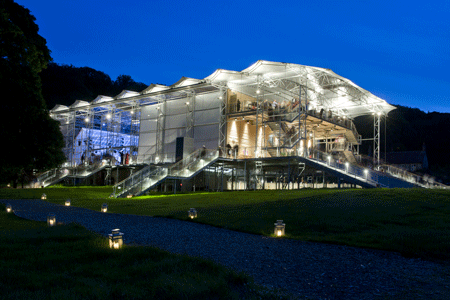 Garsington Opera at Wormsley [Photo: Richard Davies]
Garsington Opera at Wormsley [Photo: Richard Davies]
Thus it was an education to watch him direct a rehearsal of L’Olimpiade. They were doing a scene where Aristea (Rosa Bove) learns that she’s to be married to a stranger. Bove is embracing a toy lamb. The King Clistene (Riccardo Novaro) enters and quietly removes the toy sheep. “She has to grow up now and be married” says Freeman. Novaro deposits the lamb behind a rock, out of Bove’s sight. It’s a small gesture, lasting under a minute, but Freeman shows how it expresses the King’s purposeful nature. “Don’t look at the lamb” Freeman tells Novaro. Clistene isn’t interested in sheep but in his daughter and her coming of age.
At Garsington Opera at Wormlsey, real sheep roam the fields, but inside the auditorium, life size models of sheep move across the stage, pulled on wires. Of course it’s artifice. This is theatre, not nature, and Argene (Ruby Hughes) is a noblewoman, pretending to be a shepherdess as part of her strategy to win Licidas. In a bare rehearsal room, and out of context, it’s even less naturalistic, but Freeman tells the cast that the feelings in the opera are real. They have to play the scene seriously, or the irony is lost. “The audience will only find it funny if we take it completely seriously”. Some great comedians, he adds later, are very serious people: comedy throws tragedy into high relief.
“L’Olimpiade’s an Oedipus story, it’s a curse, but when Lycidas comes to kill his father he can’t bring himself to do it. It’s a tragedy but ends up as comic. We have to laugh at the most serious things. It’s extraordinary that the one thing we can rely on in life is that we’re going to die, but it’s the one thing we can’t avoid”. “L’Olimpiade is a comedy, but a comedy for serious characters, not light”, Freeman adds. “It’s a very dramatic and vigorous comedy. People try and commit suicide. It reminds me of Chikamatsu, who created those kabuki double suicide tragedies But in Vivaldi they don’t it follow through”. “What you have to do is make the recitatives work, which is true of Mozart, too. They work like dialogues in a play. You’ve got to play with great clarity. Good singers and actors of course know their text but the hard thing is that you have to learn everyone else’s text so you can react to it”. Characters make drama, whether in a play or in an opera. “An opera without drama is a very long evening indeed”.
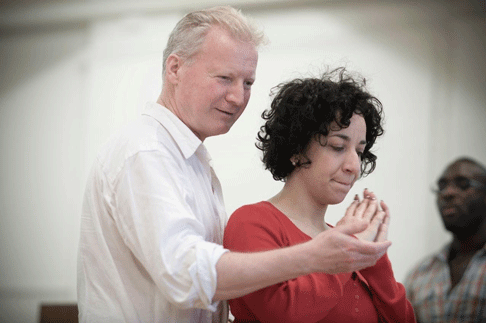 David Freeman directing Rosa Bove in rehearsals for Vivaldi
L’Olimpiade
David Freeman directing Rosa Bove in rehearsals for Vivaldi
L’Olimpiade
In L’Olimpiade, Freeman says there is some “absolutely beautiful music and it’s genuinely touching too. It’s not just pretty tunes. The music cuts pretty deep, even if the plot’s a concoction”. L’ Olimpiade is based on a text by Metastasio which was also used in other operas. Audiences would have had printed texts available, though not sheet music which was expensive to copy, so the plots would not have been wholly unfamiliar. “So there wasn’t the same close relationship between text and music that you get in Mozart or even in Monteverdi". Contemporary audiences might have enjoyed these operas much in the way that popular modern shows string together good tunes around a storyline.
“Another thing about Vivaldi”, says Freeman, “is that we tend to think of baroque as Handel. They were almost direct contemporaries, Vivaldi (1678-1741), Handel (1685-1759). But Handel was a German composer writing in Italian for an English audience, so naturally he didn’t go in for very complicated plots but for rather sublime situations. Vivaldi is different. He’s a Venetian writing for Italians, even in the Venetian dialect, for Venetian audiences, who could understand . So he was able to do a lot more, with text, with comic wit, a lot more madness. So there are more arias, even if they’re shorter, and lots more recitative. So in comparison with Handel who can seem quite noble, Vivaldi might seem more scrappy, but that’s what makes Vivaldi lively”.
Garsington Opera's new premises at Wormsley were designed to combine the countryside setting with good acoustics. "I love the way it seems to float in the open field", says Freeman, "it's surreal". This works particularly well for baroque scale works. Freeman directed A Winter's Tale one of the first plays to be mounted in the Globe theatre in London, a reconstruction of Shakepeare's original theatre. "People said that it proved the primacy of Shakespeare's text, all you need is text. But I thought the opposite. I thought the Globe setting revitalized everything. In a normal theatre, if a pigeon flies in, the audience worries, will it die, or get electrocuted? They get distracted from the play. But in the Globe, if a bird flies in, it's natural, it's just doing what birds do. And the atmosphere at Wormsley rubs off on the operas too. I think it's a triumph".
For more information, please see the Garsington Opera at Wormsley site. (includes cast and production shots)
Anne Ozorio
image=http://www.operatoday.com/David_Freeman.gif image_description=David Freeman product=yes product_title=Vivaldi’s L’Olimpiade At Garsington Opera product_by=An Interview by Anne Ozorio product_id=Above: David FreemanMay 25, 2012
Joan Sutherland and Richard Bonynge: Serate Musicali
At the core of the compilation is Rossini’s Serate musicali, a set of eight pieces, which the composer put forward for the study of Italian song, and Joan Sutherland offers a fine interpretation of the set, with her husband Richard Bonynge. These pieces set the tone, with exemplary phrasing. At times it is difficult not to think of Sutherland's operatic accomplishments while listening to her performances of more intimate literature from the nineteenth century. Some might hold that Sutherland’s voice is darker here than on recordings of similar literature that she made earlier in her career, it is nonetheless useful to hear the mature interpretations of these songs. More than that, the other Italian artsongs merit attention for the perspectives they offer on the genre, with rarely recorded works by Leoncavallo, Respighi, Ponchielli, and others.
The remarkable feature of the release is the breadth of styles that the pair execute. With the character pieces of the Serate musicali serving as a point of departure, the recording includes some moving songs by Bellini, which deserve attention for the concise expression the composer brings to such a piece as Dolente imagine di Fille mia and Maliconia, ninfa gentile. Bellini’s Vaga luna, che inargenti is another fine piece, which Sutherland and Bonynge offer seemingly effortlessly. The unique contribution by Verdi, Il poveretto, is charming for what it is, but those unfamiliar with the contributions of Donizetti will find some attractive pieces in this collection, which also demonstrates Sutherland’s command of the genre.
Of the French literature collected in this set, Sutherland’s interpretations of pieces by Massenet demonstrates the qualities in Massenet’s mélodies, as well as selected works by Bizet, Thomas, Adam, and Delibes. Cécile Chaminade is also represented here with her Berceuse, which Sutherland renders persuasively. The Iberian tones of some of the French pieces offer another aspect of literature, as found in Lalo’s L’esclave and Delibes’ Les filles de Cadix.
The studio recordings have a spacious sound, albeit with a somewhat dry acoustic. The voice is prominent, as it should be, with Bonynge supporting with fine style. Sutherland is clear and resonant, as evident in some of the elaborate melismas of the opening set of songs by Rossini. Her glissandi are clean and effective, never out of place or affected. For both performers, the dynamic ranges is appropriate to the music and captured well on the recordings. The well-produced set includes a detailed booklet with not only the full track listings, but also texts and translations of each piece, along with a short commentary on the works. This recording offers not only a different side of the contributions Sutherland and Bonynge made during their careers, but brings to life music that represents an outpouring the romanticism in the over forty pieces in this impressive set.
James Zychowicz
image=http://www.operatoday.com/Decca_4757984.jpg
image_description=Serate Musicali
product=yes
product_title=Serate Musicali — Songs, Mélodies, Lieder by Rossini, Bellini, Donizetti, Massenet et al.
product_by=Joan Sutherland and Richard Bonynge
product_id=Decca 475 7984 [2CDs]
price=$19.99
product_url=http://www.arkivmusic.com/classical/album.jsp?album_id=146042
May 22, 2012
History Repeating
The capacity audience at the Wigmore Hall was expectant, alert and palpably animated as they awaited the opening item: three of Benjamin Britten’s characterful if idiosyncratic realisations of Henry Purcell. From the early 1940s, Britten and Pears had introduced these realisations into their recital programmes; Britten would later declare that he had not appreciated “before I first met Purcell, that words could be set with such ingenuity, with such colour”. These realisations are energetic and restless, if not always idiomatic. But Davies made them sound natural and fluent, the frequent sparseness of Britten’s textures resulting in no loss of expressivity as Davies’ easy, fluid declamation of the text, particularly in the recitative-like passages, delineated the emotional situation directly and truthfully. ‘In the Black Dungeon of Despair’ was particularly transfixing, the chromatic declamations wonderfully shaped, while ‘Sweeter Them Roses’ demonstrated the countertenor’s deftness and agility. Overall it was the small details that were made to tell so affectingly: such as the subtle diminuendo on the closing ‘Hallelujah’ of ‘Lord, what is man’, or the poignant dissonances which draw out the dark sensuality of ‘Sweeter than roses’.
Recently Davies gave the world premiere of Nico Muhly’s Four Traditional Songs — comprising settings of ‘A brisk young lad’, ‘Searching for lambs’, ‘The cruel mother’ and ‘The bitter withy’ — a work which was jointly commissioned by Carnegie Hall and the Wigmore Hall. Muhly perfectly understands the need to allow space for the text to speak in these folk ballad arrangements, and his minimalist style creates an appropriately reflective, introverted, and at times mysterious, ambience. He also appreciates the wide range of register and colour which Davies’ voice can encompass — from a muscular, strong lower voice to a penetrating yet poignantly sweet high range — and the way that this can be used in the service of story-telling.
Davies knows how to spin an intimate narrative, almost like a confession, drawing the audience ever closer; by the final song the audience was collectively holding its breath, hardly daring to exhale and break the spell. The precision and control were deceptively effortless: it takes enormous skill and discipline to shape such expansive phrases, colouring individual words and subtly altering the dynamics, while maintaining narrative continuity. The vocal line was penetrating but never shrill; incisive and haunting, and at times unsettling, but always beautiful and warm. Pianist Malcolm Martineau complemented the voice economically but expressively - Muhly has described the piano accompaniment as "highly stylized but understated". Indeed, these songs may be sparse but they are also deeply eloquent and touching.
Michael Tippett did not allow Britten a monopoly of song arrangements and editions of early music, including Purcell, and Tippett’s Songs for Ariel which closed the first half of the recital, reveal his own Purcellian inheritance. In ‘Come into these yellow sands’ and ‘Full fathom five’, pianist and countertenor made much of the evolving counterpoint which energises Tippett’s idiom. A bright joyful timbre characterised ‘Where the bee sucks’, Davies nonchalantly evoking Ariel’s freedom of spirit and blissful release.
The second half commenced in more reflective, sombre fashion with Britten’s realisations of J.S. Bach’s Five Spiritual Songs. Here the elegance of Davies’ phrasing, as well as his full rich tone, conveyed both the disturbing and consoling moments in the texts with equal affective power. Again, it was the remarkable yet inconspicuous attention to small nuances which proved so moving: the careful placement of the words, ‘Es ist gnug, Herr’ in ‘Liebster Herr Jesus’, each isolated by the most miniscule of separations, was spine-chilling.
Davies found himself in unfamiliar countertenor territory for the next item, Schubert’s lied, ‘Der Tod und das Mädchen’. In fact, his timbre gave a song where voice type and manner are innately provocative, an added piquancy. For, the singer must embody two differently gendered roles: first, a maiden who pleas for death to pass her by, and then Death himself, who reassures that it is rest not terror that he brings. The shift from the maiden’s high register to Death’s lower realms is further complicated by the countertenor timbre — one might describe the effect as a serious version of more familiar comic, en travesti subversions. Davies’ lower range is muscular, even tenorial, which made the sepulchral descent through a D Minor scale and the chilly repeated Ds to which Death’s melody repeatedly returns, deadening and bleak. Although there was little of the emotive vocal strain at the close that is inevitable when the song is sung by a woman, Davies was able to convincingly convey both the agitation of the maiden in the first stanza and Death’s knelling reply, making the intermingling of personae even more unsettling. Martineau’s funereal piano prelude was transformed into a hymn-like postlude, further highlighting the ambiguities of the text.
Brahms’ Fünf Gesänge Op.72 is the last of four sets of songs composed during 1875-77. The first song, ‘Alte Liebe’, has a text by Candidus which speaks of the memories of young love — sentiments which undoubtedly resonated personally for Brahms. Martineau proved himself a sensitive and intelligent accompanist in these songs, in which the vocal line and accompaniment textures are intricately interwoven. Davies’ slow vocal phrases unfolded expressively over Martineau’s gentle, low register arpeggios, but harmonic intensification rapidly injected restless passion, before subsiding to a resigned close, with falling fifths resounding emptily in the piano accompaniment.
Translated as ‘Invincible’, ‘Unüberwindlich’, the fifth of the Op.72 set, is Goethe's drinking song, comparing women to wine. Both pianist and singer displayed a sharp wit and light spirit, making much of the humorous word-painting and ironic musical quotation (a motif from Domenico Scarlatti's harpsichord Sonata in D (Longo 214). The performers enjoyed the drawn out octaves between the voice and piano which mark the several oaths sworn during the song, and the conclusion was suitably uproarious.
Herbert Howells, nostalgic song, O My Deir Hert, was performed with particular sweetness, Davies’ luminous tone aptly conveying the faith and passion of the Luther-inspired text.
During his last months in America in the mid-1940s, Britten assuaged his homesickness by producing many arrangements of folk songs of the British Isles, which he and Pears performed as encores. Britten noted at the time that they created a “’wow’ wherever they have been performed so far!”, and Davies kept up this tradition! The relaxed joyfulness of ‘That yongë child’ was followed by an exquisitely crafted rendering of ‘The Ash Grove’, the vocal melody enhanced by Martineau’s delicate accompaniment, commencing high above the voice, then sinking deep below before rising to ethereal heights once again for the close. ‘Oliver Cromwell’, a setting of a traditional Suffolk nursery rhyme, places a comically malicious text over a smirking piano accompaniment, in a vibrant folk style. The final lines are: “If you want any more, you can sing it yourself, Hee-haw, sing it yourself.” The audience undoubtedly wanted much more, but Davies’ artistry rendered any other contributions unthinkable!
Davies seems to have it all. His tone is pure and centred, unfailingly beautiful across all registers, never ceasing to make an expressive or dramatic impact. Intonation is near perfect, technical demands are effortlessly despatched, and Davies communicates directly with his audience, confident and direct in a range of styles and forms. There is no undue fussiness but subtle details are perceived, considered and strikingly conveyed. Such innate musicality and unassuming mastery are rare, and to be treasured; as are the apparent joy and delight both experienced and shared — which the exultant Wigmore Hall clientele clearly understood.
Claire Seymour
Programme:
Henry Purcell: ‘Lord, what is man’ (realised by Britten);
‘In the black, dismal dungeon of despair’; ‘Sweeter than
roses’
Nico Muhly: Four Traditional Songs (UK premiere)
Michael Tippett: Songs for Ariel
J.S. Bach: Five Spiritual Songs (Geistliche Lieder)
Franz Schubert: ‘Der Tod und das Mädchen’
Johannes Brahms: ‘Alte Liebe’; ‘Unüberwindlich’
Herbert Howells: ‘O my deir hert’
Benjamin Britten: ‘That yongë child’; ‘The ash grove’;
‘Oliver Cromwell’
May 21, 2012
Semele, Canadian Opera Company
Both the adventurous staging and the consistently brilliant singing make Handel’s Semele by far the best opera production I’ve seen from the COC.
Luckily I had my backstage preview of the opera that gave me a chance to wrap my head around this most original approach to Semele in the piece I posted a few days ago. My expectations were confirmed, the production doing pretty much what I’d expected. I had wondered if the COC would allow the liberties with Handel that (director) Zhang Huan took in the two previous incarnations (in Belgium & later China). They did indeed.
I am going to explain where I am coming from. Opera purists who come to a performance expecting -or demanding—that the usual procedures be followed might take issue with this production, as they have in New York with the Lepage Ring cycle. Just as Lepage strove to get back to the original text -albeit via an expensive modern production—so it would appear do Zhang.and his team.
But how, you may wonder, can a production using a dancing horse, a Tibetan singer, sumo wrestlers, puppets and finishing with a version of the Internationale, be in any sense faithful? I think the problem is in how we understand the work.
Semele began as a Lenten oratorio, making it a bit of an oxymoron if one considers that this erotically charged work was fashioned to premiere in the season of restraint. It’s in the most curious balance between the rational and the passionate, frequently stepping back to make detached commentaries about its action through its chorus, then giving one of the principals the opportunity to explore their feelings. The schizophrenic push-me pull-you style of baroque oratorio (or opera) is hyper-repressive, in the way that action moves in discreet chunks, followed by a lengthy exploration of a passion in the stasis of an aria. To a Martian -or come to think of it, a Chinese installation artist such as Zhang—Handel’s oratorio would seem very odd. It doesn’t really have a native performance style, having been uprooted from the beginning, in the almost immediate rejection of this style by the London public, a kind of exile that’s never really had a proper home, but was always something of a fish out of water. The worst thing one could do is stage it as though it were realistic, as some have attempted.
In the 18th century, opera was a very different experience from what we get now. If you had Juno & Semele onstage together they would both be dressed in lovely attire, but without any clear indication what century they were to portray, let alone the kind of precisely coded costuming and set one frequently encounters nowadays. I believe that were a baroque performer suddenly resurrected in Toronto and shown the three operatic programs currently being staged, they’d find Zhang’s approach - where the set is merely a context rather than an attempt to simulate a world—highly congenial and recognizable, while feeling a bit odd on a set from a specific time (as you find in Gianni Schicchi or Contes d’hoffmann). I believe this production is far more congenial to the work than the conventional / purely representational approaches.
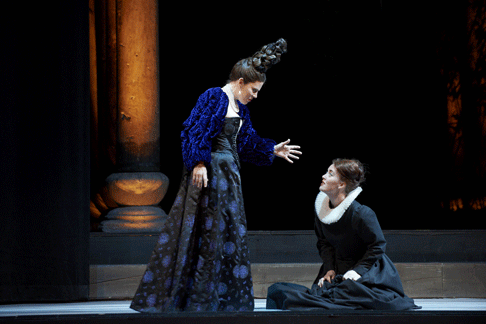 (l - r) Allyson McHardy as Juno and Katherine Whyte as Iris
(l - r) Allyson McHardy as Juno and Katherine Whyte as Iris
That Zhang chose to substitute parts of the opera might also upset purists, but in the 18th century it was the way opera was done. I’m not saying Zhang read about suitcase arias, but I applaud his choices on the grounds that any purist defending Handel on grounds of textual integrity needs to remember that such principles are always relative to the century you’re working in.
Sigh. I did run into a couple in the elevator who left at the intermission. Of course I was grinning like a 5 year old and said “how did you like it,” not expecting that anyone felt different than I did (and the house had erupted in applause at the end). When I talked to them they were pleasant but seemed mystified by the production, which mixes serious (a 450 year old Buddhist temple, a tale of gods and mortals) and silly (an inflatable puppet, a dancing horse, sumo wrestlers), and couldn’t understand my enthusiasm, which I was unable to conceal.
For me, Zhang’s production feels like a production from first principles, addressing fundamental questions about what it is to be human or immortal, to be incarnated in a body or concealed in another form (and this is true of both of the gods as well as the temple that is the set). Those thoughtful arias and choruses that seem too rational for real life make sense in this inter-life place, a temple where souls come to be incarnated, or comment afterwards (as Semele does). The odd mix of styles and cultures-of Handel in English, a Tibetan song, a pair of sumo wrestlers, and to finish, the Internationale—are properly multi-cultural, as if in a magical place that is all cultures and no cultures, a forgiving mix that is a reflection of this oddball opera.
In a more typical production of Semele I’d be feeling a bit strange about Juno, Jupiter and Semele, who would look like opera singers onstage, even though one purports to be mortal, while the other two are supposedly gods. If, however, we’re in this odd space suggesting souls seeking peace, the abstract conversation makes much more sense. I no longer mind that a god and a mortal are side by side, because they’re in a virtual space for the incarnation of souls, as we might see for example in Noh theatre.
This is the most sensual opera I have ever seen. There’s more touching, more allusions to sexuality, more pure passion than I’ve ever seen in a production of Tristan und Isolde (Wagner lovers take note). The chorus were often pressed into service as if they were illustrations in a sex-ed textbook, or failing that, used for their voyeuristic potential when Jupiter & Semele were at it.
Tenor William Burden was a very believable Jupiter, singing the opera’s best known tune, “Where e’er ye walk”, a concretely sensual exploration of Semele, massaging and washing the feet of Jane Archibald as she lay on her back before him. Elsewhere, his cadenzas were opportunities to teasingly manhandle her, the god bewildering her with his physical dominance.
Semele is also very funny. Juno is jealous of Semele, and because we’re seeing a production unafraid of the text, the humour is very close to the surface. Allyson McHardy has no remorse leading Semele to her doom, gleefully celebrating. The voice reminds me of Janet Baker, with consistent richness well below middle C, and wonderful musicianship. I would have been happy had she been the star, thrilled by her singing.
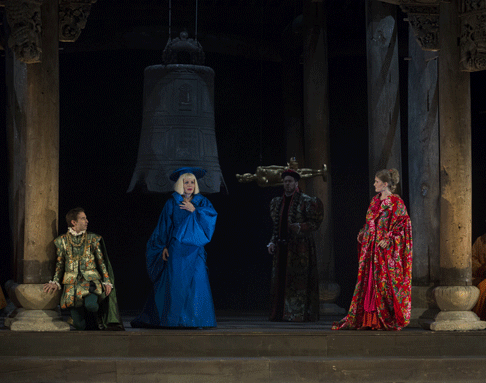 (l - r) Anthony Roth Costanzo as Athamas, Allyson McHardy as Ino, Steven Humes as Cadmus and Jane Archibald as Semele
(l - r) Anthony Roth Costanzo as Athamas, Allyson McHardy as Ino, Steven Humes as Cadmus and Jane Archibald as Semele
The cast is one of the strongest seen at the Four Seasons Centre in recent years, with no weaknesses, Semele was especially strong, as played by Jane Archibald. There are several arias that stop the show, particularly the third act aria “My self I shall adore”. A disguised Juno presents Semele with a mirror that makes her ever more vain & self-loving. The set design made the entire stage a colossal mirror, reflecting the theatre back to itself. Archibald coyly played to this huge mirror, never seeming at all taxed in this most difficult of arias. I suddenly remembered: they premiered the opera two nights ago, yet Archibald was singing effortlessly, popping out what sounded like a high F above a couple of Cs in that aria, a D in another aria, and showing several different types of singing. Archibald all by herself is actually better than any opera presented this season, perhaps the best coloratura in the world right now, a gorgeous, witty actress playing the part with such complete ease that we get lost in her humour or her pathos.
Archibald and McHardy are still quite young, so that we can hope to see their talents re-united again. They sound wonderful together.
The COC orchestra played like a period ensemble due to the leadership of conductor Rinaldo Alessandrini. There was a time that the only way to get a particular timbre was with one of the historically informed performance ensembles such as Tafelmusik. While there’s no real substitute for the gentle sounds of such an orchestra, conductors are now able to bring their scholarship to the performance of modern instruments. The COC orchestra had a previous experience like this with Harry Bicket leading them in Orfeo ed Euridice a couple of years ago. Then as now, you might have wondered whether they were playing on different instruments.
I am thrilled that I already have tickets to another later performance. You must see this, if only for Archibald’s heroics in that amazing aria, but also for the lovely sound of Allyson McHardy, the playing of the COC orchestra, the COC chorus’ outstanding performance, and the beautiful set.
The Canadian Opera Company production of Semele continues until May 26 at the Four Seasons Centre in Toronto.
Leslie Barcza
[This review first appeared at barczablog. It is reprinted with the permission of the author.]
image=http://www.operatoday.com/semele-mc-d-1870.gif image_description=Jane Archibald as Semele (foreground) and William Burden as Jupiter (background) [Photo by Michael Cooper courtesy of Canadian Opera Company] product=yes product_title=G. F. Handel: Semele product_by=Click here for cast and other information regarding this production. product_id=Above: Jane Archibald as Semele (foreground) and William Burden as Jupiter (background)Photos by Michael Cooper courtesy of Canadian Opera Company
May 19, 2012
Billy Budd — Metropolitan Opera
New Yorkers have been preparing for this all season—longer in the case of Karita Mattila’s Emilia Marty, a role she undertook for the first time only last autumn in San Francisco. The Met’s production, designed to showcase Jessye Norman’s majestic figure and presence, may not quite suit Mattila’s more athletic performing style and Nordic looks (neither of them seems especially Greek, the nationality of Elina Makropoulos), but the mating of Jánaček and Mattila is very near ideal, and if she no longer sounds like the young, idealistic Jenufa or Katya Kabanova, well, Elina/Emilia is 337 and should give some evidence of wear and tear. It was a thrilling occasion, and the Met surrounded her with a fine supporting cast led by Jiří Bělohlávek, perhaps the finest conductor of Jánaček since Sir Charles Mackerras.
John Dexter’s production of Billy Budd is always welcome. This is one of the rare occasions a producer has made proper use of the size and proportions of the Met stage, its stage machinery and its lighting effects, filling it without crushing the life out of the human beings singing the drama, everything in proportion, with an excitement that suits the composer’s intentions at every turn. Dexter also achieved this sublime match of score and production in his far simpler (and cheaper to mount) version of another masterpiece of the 1950s, Poulenc’s Les Dialogues des Carmelites, which will return next season. In Billy, the crowded cast has no problem staying out of each other’s way and William Dudley’s multi-leveled ship rises and descends noiselessly, highlighting the confrontations and interactions necessary to the plot—as Scott Pask’s sets for John Doyle’s production of Peter Grimes so conspicuously failed to do.
I had not noticed before that Dudley’s costume for Billy, a gleaming white, highlights him against the dirtier or grayer costumes of the other sailors, in or out of the spotlight. No matter what else is going on, we always know where Billy is and what he is doing—and, importantly for a hero unjustly accused of crime, what he has not done. It has also never been clearer to me that Billy is something of a Savior figure here for the deeply Christian Britten, his goodness and beauty calling immediately to the goodness in every other character and arousing the furious hate (and, one naturally guesses, unassuageable lust) of the evil one, Claggart. Captain Vere’s regret that he did not devise some way to save Billy is a link, in Britten’s view, to the Fall of Man through inaction to prevent evil.
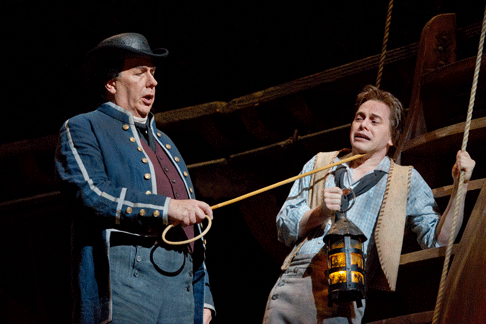 James Morris as Claggart and Keith Jameson as the Novice
James Morris as Claggart and Keith Jameson as the Novice
Billy Budd is a grand opera (the second of Britten’s three) composed in the manner of a chamber setting, with each instrument set conspicuously separate rather than the romantic, sensuous, string-heavy texture of turn-of-the-century opera. Actions are accompanied by twittering figures for flute, keening figures for saxophone, outbursts for brasses in astringent combinations, tidal cellos and basses under the great tragic meditations. Even the all-male chorus seems to bring light, instrumental color to the story rather than the choral mass we expect of a nautical story, such that their wordless, gut-deep reaction to Billy’s unjust execution seems to come from a surprising emotional place, a place the story has not yet explored, that we had not thought Britten would explore. We are shocked and impotent at the crime, just as the sailors are, just as we are intended to be; we are drawn into the tale, unable to be mere spectators to it.
Billy Budd is a very personal work, the creation of a Christian, a homosexual, a pacifist and an ironist. An artist who was not all these things could not have done justice to the moral clarity and the absence of clarity in Melville’s tale. Claggart’s credo is modeled on that of Verdi’s Iago, whose “motiveless malignity” seems to emerge from a sheer love of the power to do harm. Nothing Iago tells us of his reasons to hate Otello (and he never suggests any personal dislike of Desdemona, his tool to destroy her husband)
Britten’s pacifism is the message of the great war scene when the sailors (and those hearing and watching them) are thrilled by the great action after inaction, a “stock” war scene from so many grand operas—only to have the enemy escape after a single shot is fired and the heavily symbolic mist closes in, frustrating everyone but the evil Claggart, whose trap for Billy can now be sprung. We are meant to take the fog, the confusion, as the moral mess of any mob howling for the blood of strangers. That none of these simple sailors lost in a moral fog gets quite what he bargained for in the scenes that follow the thrilling buildup is Britten the ironist and moralist, whose bitter settings of Wilfred Owen’s poetry would soon enhance his setting of the Requiem text for the inauguration of the reconstructed Coventry Cathedral.
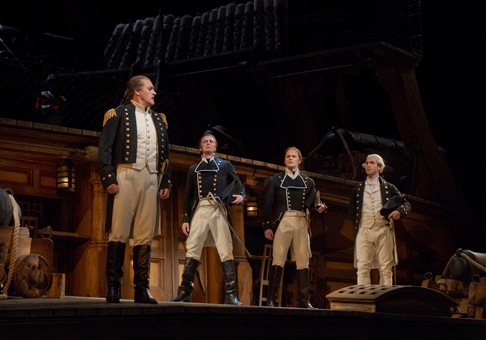 John Daszak as Captain Vere, Dwayne Croft as Mr. Redburn, Ryan McKinny as Mr. Ratcliffe, and Kyle Ketelsen as Mr. Flint
John Daszak as Captain Vere, Dwayne Croft as Mr. Redburn, Ryan McKinny as Mr. Ratcliffe, and Kyle Ketelsen as Mr. Flint
In the current Met run, Nathan Gunn, a singer of little subtlety and a rather crooning style more appropriate to old Broadway than to opera, takes on the role of Billy for the first time at the Met. After a gruff opening scene, he inhabits the “handsome sailor’s” naïve physicality, dancing, fighting, suspecting no evil, grateful for (and inclined to return) everyone’s affection. His resigned final monologue was his most moving work, though his diction was sometimes indistinct. Claggart is a role that has long belonged to James Morris at the Met, but his voice has dried out considerably and the sensuous menace he used to suggest has faded with it. John Daszak, an English tenor, made his company debut as Vere, too weak to respond to Billy’s plea to for salvation and insufficiently ruthless to suppress his doubts. In the monologues that open and close the opera Daszak’s every word rang clear. He was also visibly shaken at having to preside over Billy’s execution.
The opera’s many smaller roles were ably filled by both old-timers and newcomers. Veteran John Cheek was a delight as the Dansker; Dwayne Croft (a sometime Billy) and Kyle Ketelsen excellent as Captain Vere’s supporting officers; Allan Glassman and Mark Schowalter did good work as Billy’s fellow impressed seamen. Scott Scully as the treacherous Squeak and Scott Jameson as the self-hating Novice sang beautifully and were riveting in their scenes of corruption and weakness.
There is something very satisfying about attending so familiar a production of so intriguing an opera and knowing from the first mysterious notes that all will go well, that the opera is right for the stage, that the staging is right for the opera, that the performers are itching to get at our ears and eyes and hearts, as the sailors in the great “This is the moment” set piece are itching to get at the French enemy. I almost envy those who came to Billy Budd not knowing the opera or the production and were astonished by its excitement.
John Yohalem
image=http://www.operatoday.com/Billy_Budd_Met_2012_01.gif image_description=Nathan Gunn as Billy Budd [Photo: Ken Howard/Metropolitan Opera] product=yes product_title=Benjamin Britten: Billy Budd product_by=Captain Vere: John Daszak; Billy Budd: Nathan Gunn; Claggart: James Morris; Dansker: John Cheek; Mr. Flint: Kyle Ketelsen; Novice: Keith Jameson; Squeak: Scott Sculley; Mr. Redburn: Dwayne Croft; Red Whiskers: Allan Glassman; Arthur Jones: Mark Schowalter. Production by John Dexter. Chorus and orchestra of the Metropolitan Opera, conducted by David Robertson. Performance of May 4. product_id=Above: Nathan Gunn as Billy BuddPhotos by Ken Howard / Metropolitan Opera
Damrau Dazzles in Geneva
The Divine Miss D immediately serves notice that she has no current equal in this repertoire, singing with a pristine beauty of tone, displaying effortless coloratura effects, and effectively modulating her beautifully limpid soprano from full-bodied forte to hushed pianissimo and all points in between. Moreover, Diana is a consummate stage creature who is capable of fully investing the character of the scheming coquette with endlessly inventive stage movement and business.
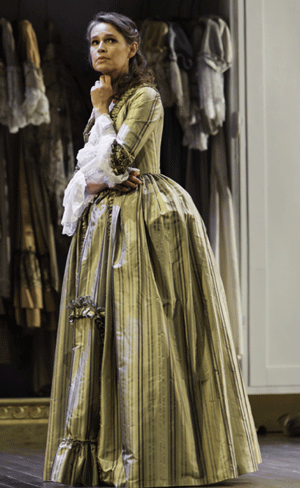 Sophie Koch as Mignon
Sophie Koch as Mignon
Ms. Damrau not only boasts one of the most technically secure instruments in the business, she also has that elusive star quality that makes us unable to take our eyes off of her, with our ears joyously coming along for the ride. While it is no surprise that she crafts “Je suis Titania” as a veritable Masters Class in poised vocal perfection, the truth is that she makes nary a false move the entire evening. If Thomas were alive, he would most certainly write her back on stage in Act Three! Petite in physical stature perhaps, but Diana Damrau’s Philine is a towering artistic achievement that had me from “Bon jour.”
But the piece is called Mignon after all, and here too, Geneva cast from strength. One of the most celebrated (and busiest) French mezzos of our time, Sophie Koch gifted us with a deeply felt, wholly engaging performance. Her refined lyric voice has a hint of a dusky hue to it, and Ms. Koch is quite expert at crafting affecting plangent phrases. “Connais-tu le pays” was polished and poised, touching yet avoiding bathos. She also made Act Three her own with a solid understanding of the soft-edged dramatic and musical momentum.
Time and further experience with the character will likely lead this gifted performer beyond the somewhat generic to a more nuanced approach, by discovering a bit more variety that could be mined from the part. And she will no doubt refine the few phrase endings that lost focus or were characterized by a frayed release. Still, Sophie’s dramatic commitment was believably sincere, and she skillfully deployed her mezzo with admirable results.
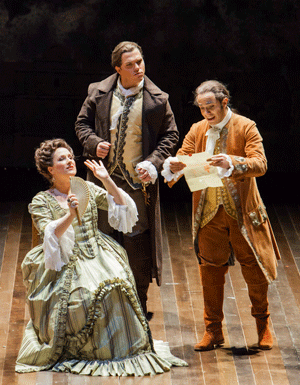 Diana Damrau as Philine, Paolo Fanale as Wilhelm Meister and Emilio Pons as Laërte
Diana Damrau as Philine, Paolo Fanale as Wilhelm Meister and Emilio Pons as Laërte
Paolo Fanale showed great promise as Wilhelm Meister. When Mr. Fanale sings at mezzo forte he impresses mightily with as creamy a lyric tenor as you are likely to hear. He also offers some superlative diminuendo effects that are cleanly executed. His upper range rings out freely and with amplitude well above the staff. However, at louder volumes in mid- and upper-range I had the impression that he was more forcing the placement into the mask than allowing it to simply be in the mask.
This is not to say it was unpleasant to the listener, but rather a bit worrisome for his future vocal health. Paolo is young, handsome, musical, and is possessed of a naturally glowing tenor. He is needed. While his Meister had much to recommend it, I would urge him to fine tune his vocal approach and liberate the tonal production in the passaggio. If more French opera is in his future, he might also be more attentive to his diction and nurture more comfort with the language.
Nicolas Courjal earned one of the biggest ovations of the night for his masterful Lothario. His gently throbbing vibrato and slightly grainy bass-baritone were perfectly matched to the rangy vocal lines of this highly sympathetic personage. Mr. Courjal was able to spin some flawless messa di voce effects and pour out any number of well-judged legato phrasings with a refinement that is not all that commonly encountered in this Fach.
Emilio Pons made his usual fine impression in the small-but-important role of Laérte. Mr. Pons was luxury casting, not only showing off an even, easily produced tenor of good ping and presence, but also declaiming some of the most idiomatic French dialogue of the cast, vivid and characterful. Emilio clearly relished his conspiratorial scene work with Diana’s Philine, who created real sparks as they prodded each other to ever more animated machinations.
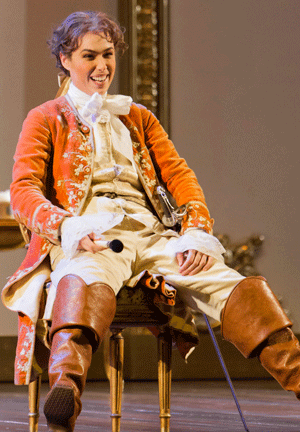 Carine Séchaye as Frédéric
Carine Séchaye as Frédéric
Carine Séchaye had lots of fun with her goofy take on Frédéric. Her slightly steely mezzo had style and spunk, and her comic invention invested this suitor with a decidedly fresh perspective. As the meanie Jarno, Frédéric Goncalves avoided dramatic cliché and sang with an assured, virile baritone. In the inserted, mute role of the Servant, comic actor Laurent Delvert scored some good laughs as he set up ‘audience’ seating for the gypsy show during the overture’s Polonaise. The chairs were slid forcefully on stage on their backs from the wings, coming in ever-greater numbers and speed. Just as he finally got them all set up stage left, he suddenly realizes they should in fact be stage right. In a burst of manic madness he moved them all to the other side as the band played the frenetic finale.
Would that all of the stage direction had been similarly inspired. On the plus side director Jean-Louis Benoît did not get in the way of his first rate cast. Nor, however, did he add too much that was inventive or creative. He did manage the traffic well enough, groupings were clean and focused, and principal characters were never upstaged by irrelevant movement. Nor did the actors always seem to be fully connected, as Mr. Benoît was content to have them sing to us rather than each other, which was especially noticeable with Mignon and Wilhelm in Act Three.
While this did enable the singing to be heard to maximum effect, it did weaken the dramatic involvement in a piece that would benefit from more fully involved character interaction. “Je suis Titania” began with a very effective visual “build” which started with Philine on a platform up center and had her moving incrementally to the apron flanked by the chorus. But then the soprano was made to return way upstage for the finale, a visual, if not vocal retreat. The director might reconsider and let his star shine down stage through the end of the aria.
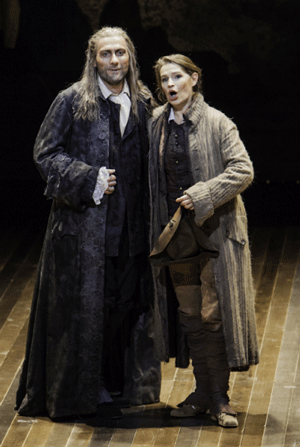 Nicolas Courjal as Lothario and Sophie Koch as Mignon
Nicolas Courjal as Lothario and Sophie Koch as Mignon
Laurent Peduzzi’s sets were not particularly detailed nor meant to be, but at least they did not distract. A false proscenium here, a drape there, a lone bed at one point, a sole armoire at another, all were carefully chosen and the whole was quite nicely showcased by Dominique Bruguiére’s well-judged lighting design.
The real design achievements of this production were the lavish, richly detailed period court costumes by Thibaut Welchlin. Too, the fanciful Shakespearean get-ups for A Midsummer Night’s Dream were delightfully eye-catching. What a shame then that this accomplished costumer made the miscalculation of dressing the title role in a well tailored man’s suit for her entrance (clambering out of a clothes hamper no less). Instead of looking like a somewhat androgynous, enigmatic gypsy girl, the lovely and statuesque Ms. Koch looked instead like Octavian wandered in from a bus and truck tour of Rosenkavalier. Mignon was thereby handicapped with attire that made her look more hangdog teenaged boy than melancholy love struck waif. And it made hash of the script’s requirement that Meister subsequently demand that Mignon indeed disguise herself as a man servant. Huh?
In the pit, Frédéric Chaslin made a strong case that he may just be the world’s leading conductor of this repertoire. The splendid Orchestre de la Suisse Romande collaborated with the Maestro to produce a reading that featured delicately refined solo work, richly rendered ensemble passages, and tremendously detailed layers of instrumental colors. The elegant harp solos alone were worth the price of admission. The chorus was meticulously prepared, tightly focused, and vibrantly emotive. Mr. Chaslin has elicited as persuasive a rendition of this gentle character study as will likely ever be heard, with an overall propulsive arc that was marvelously sustained for the entire evening.
Mignon’s starry cast, credible design elements, competent direction and superior musical values total up to a world-class opera-going experience.
James Sohre
image=http://www.operatoday.com/Mignon_GTG_02.gif image_description=Diana Damrau as Philine [Photo by GTG / Yunus Durukan] product=yes product_title=Ambroise: Thomas: Mignon product_by=Mignon: Sophie Koch; Wilhelm Meister: Paolo Fanale; Philine: Diana Damrau; Lothario: Nicolas Courjal; Frédéric: Carine Séchaye; Laérte: Emilio Pons; Jarno: Frédéric Goncalves; Servant: Laurent Delvert; Conductor: Frédéric Chaslin; Director: Jean-Louis Benoît; Set Design: Laurent Peduzzi; Costume Design: Thibaut Welchlin; Lighting Design: Dominique Bruguiére; Choreography: Lionel Hoche; Orchestre de la Suisse Romande product_id=Above Diana Damrau as PhilinePhotos by GTG / Yunus Durukan
May 17, 2012
Véronique Gens, Wigmore Hall, London
Over the years we’ve heard many specialists in French song at the Wigmore Hall, but Gens perhaps outshines them all. With her background in baroque, lucid purity comes naturally, but she also sings with exceptional intelligence. It’s hard to explain why she’s so distinctive, but her final encore (of three) might suggest an answer. Roses, jasmine and orange blossom infuse Gabriel Fauré’s Les roses d’Ispahan. The vocal line moves gently like the breeze in the text. Yet the song is not about flowers but lost love. It’s all the more poignant because it’s so subtle. Gens doesn’t dramatize, but lets the perfumed elegance convey depth of emotion.
Last December, Gens created an esoteric selection of relatively little known songs by Massenet, Gounod and Reynaldo Hahn. Now she chose a more familiar programme: Fauré, Chausson, Debussy, Duparc and more Hahn. Fauré’s Au bord de L’eau (op 8/1 1875) and Après un rêve (op 7/1 1877) were poised, but Gens created even greater interest with Lydia (op 4/2 1870) to a poem by Leconte de Lisle. “Je t’aime et meurs, ô mes amours. Mon âme en baisers m’est ravie!” Love and death so intertwined that we can’t be sure that Lydia is alive at all.
Henri Duparc’s L’invitation du voyage (1870) is so famous that it’s true meaning can be missed. The poet is Baudelaire, after all. The piano part (Susan Manoff) is limpid and delicate. These rippling waters might suggest Schubert, but the idiom is entirely different. No “gothic” histrionics here. The passion is cool but sinister. Similarly, Duparc’s Romance de Mignon (1869) is decidedly un-German though it’s based on Goethe’s Mignon song Kennst du das Land? The drama’s more muted, though the feelings are just as deep. These days it’s fashionable to disregard idiom but for me that’s bad taste. What’s the point of performing different composers in the same way? Musically-informed is much more literate. Gens and Manoff show how Duparc’s Mignon springs from a different aesthetic. Gens followed with Debussy’s Fleur des Blés (1881) and Nuit d’etoiles (1880) which are almost her signature tunes. Her recording of Debussy, Fauré and Poulenc with Roger Vignoles (2000) is very good indeed.
Normally I don’t describe what a singer wears, but Gens returned after the interval in a remarkable dress slit up to her midriff, but discreetly held together with tulle. Strikingly elegant, it raised gasps of admiration from the audience. She seemed inspired, her performance in the second part of the programme quite divine. Like the hummingbird in Ernest Chausson’s Le colibri (op2/7 1882) Gens glistened “comme un frais rayon s’échappé dans l’air”. Her Les papillions (op 2/3 1880) hinted at erotic secrets in a refined manner. The sorrow in Les temps de lilas (op 19 1886) was expressed with elegant dignity.
Gens and her pianist Susan Manoff concluded with seven songs by Reynaldo Hahn. Hahn imbibes from exotic sources, so idiosyncratic and so over the top. In three songs from Études latines (1900) Lydé, Tyndaris, Pholoé), he gets carried away with Leconte de Lisle’s elaborate fantasies of fake Antiquity. Gens and Manoff catch Hahn’s effusive high spirits. These put the famous A Chloris (1916) into context. Hahn’s hamming up again, this time with Bach. Beautiful as the song is, it’s mischief in music. Appropriately, Gens and Manoff concluded this evening of songs ostensibly about flowers and birds with Hahn’s Le printemps (1899). Hahn’s ebullient, exuberant and exhilarating — banished are the “flowers of evil”. “Te voilà, rire du Printemps!”, sang Gens, with a glorious flourish.
Anne Ozorio
image=http://www.operatoday.com/Veronique_Gens.gif image_description=Véronique Gens [Photo © M. Ribes & A. Vo Van Tao Virgin Classics] product=yes product_title=French Song: Fauré, Chausson, Duparc, Debussy, Hahn product_by=Véronique Gens, soprano; Susan Manoff, piano. Wigmore Hall, London, 10th May 2012. product_id=Above: Véronique Gens [Photo © M. Ribes & A. Vo Van Tao Virgin Classics]May 12, 2012
Bartók and Szymanowski, Barbican Hall
Where the first concert had inserted Szymanowski’s Second Violin Concerto between Debussy’s Images and Scriabin’s Poem of Ecstasy, here Szymanowski’s Third Symphony, the ‘Song of the Night’ was preceded by two Bartók works.The Szymanowski symphony provided a fitting climax, and made for an interesting contrast with another recent London performance, from Vladimir Jurowski and the London Philharmonic Orchestra. In almost every respect, Eötvös’s performance proved superior. Eötvös’s, or rather Boulez’s, programme made a great deal more sense too. (There will, extraordinarily, be a third London performance later in the year, or rather two performances on 11 and 18 December, again from the LSO, conducted by Valery Gergiev.)
In the opening bars, Eötvös imparted a fine sense of purpose, of onward tread, which had often been lacking in Jurowski’s somewhat meandering account. Yet there was no loss of delight in sonority, nor of fantasy from an LSO very much on top form. Steve Davislim in his opening line, ‘O nie śpij, druhu, nocy tej,’ (‘O! Sleep not, my dearest friend, this night’) immediately announced himself more commandingly than Jurowski’s tenor, more fervent, even possessed, for there was here and elsewhere a fine sense of mysticism to the performances of all concerned. Where Jurowski had often skated over the surface and had misplaced one particular climax, here one truly felt that Eötvös knew where he was going, climaxes expertly prepared and executed. Orchestrally and chorally – for the London Symphony Chorus was on equally wonderful form – this was not just a magic carpet of sound; it was a carpet that took us somewhere. Eötvös was, in that typically Wagnerian dialectic, both more ‘symphonic’ and more ‘musico-dramatic,’ the one quality contributing to the other. Not only did he exhibit a fine command of rhythm, including harmonic rhythm; he also communicated musical ‘character’, whether or no Szymanowski’s ‘song’ embodies an actual ‘story’. The opening of the second stanza was again noteworthy for Davislim’s mystical yet commanding performance: ‘Jak cicho. Inni śpia.’ (‘How peaceful it is. All the world is sleeping.’) However, it was equally remarkable for the Nietzschean stillness (hints of Also sprach Zarathustra, both in Nietzsche’s and Strauss’s versions, perhaps of Mahler’s Third Symphony too) from the orchestra and a duly awestruck chorus. Orchestral memories of Tristan und Isolde soon verged upon the overwhelming: this is Night, after all. And the chorus sounded explosions in the heavens. Yes, contra Nietzsche, one can, indeed must, transcend, even if only momentarily. And was that an echo of another transfiguration, Schoenberg’s Verklärte Nacht, in the orchestral conclusion?
Bartók’s Music for Strings, Percussion, and Celesta had found the LSO’s strings and percussion on fine form too. I very much liked the questing opening, violas going so far as to evoke the stirrings of Mahler’s Tenth Symphony. There was a true darkness to Eötvös’s performance, almost Romantic, but avowedly of the twentieth century, a darkness that characterised both mood and trajectory, ‘fearful symmetry’ indeed. And how splendid it was to benefit from a full orchestral string section, with no half-way house of a chamber compromise. That certainly enabled a highly dramatic performance of the fugue to emerge, as enveloping, as arresting a drama, so it seemed, as Bluebeard’s Castle itself. The second movement benefited from the placing of the violins – crucial in this of all works – to the extent that one had a sense of versicle and response, properly ‘antiphonal’ (a word seemingly often employed by people not entirely sure what it means). Rhythms were sharp without a hint of showiness. The contrapuntal delights of both work and performance seemed to evoke Bachian ‘invention’ in more than one sense. (One could hardly fail to think of Mikrokosmos.) The slow movement was wonderfully eerie, ‘night music’ that suggested as much a menacing toy kingdom, a Nutcracker turned sour, as ‘mere’ Nature. And there was a Bluebeard-like sadness underlying the violence, a vale of tears that had no need of staging. The finale was taken at quite a lick, though there were a few tempo adjustments later on that did not entirely convince. For the most part, however, this was a performance secure in direction. Again, Bachian antecedents were to the fore: a Transylvanian Brandenburg Concerto perhaps?
Of the three performances, it was that of Bartók’s Second Violin Concerto that slightly disappointed, mostly on account of the first movement, in which soloist Nikolaj Znaider seemed curiously disconnected from the orchestra. Znaider is a musician I admire greatly, but here his approach seemed somewhat sectional, and lacked a real sense of interplay with the LSO, whose musicians could hardly be faulted. Perhaps it was telling that it was only really in the cadenza that Znaider’s first-movement performance ignited. What came thereafter, including the conclusion to that movement, seemed far more responsive, far better integrated, giving a sense of what might have been. The slow movement continued in that vein; the violin sang soulfully, nobly, but now sounded infinitely better ‘connected’. Its central scherzando material was sharply etched. The finale, though it had occasional reminders of earlier disengagement, proved highly successful in voicing the sheer range of Bartók’s thematic expression, in both solo and orchestral parts. Znaider’s tone was seductive, but never for its own sake. Here was a foretaste of the emotional commitment we should fully experience in Szymanowski.
Mark Berry
image=http://www.operatoday.com/Peter_Eotvos.gif image_description=Peter Eötvös [Photo © Jean-Francois Leclercq (jfleclercq@free.fr)] product=yes product_title=Béla Bartók: Music for Strings, Percussion and Celesta; Violin Concerto no.2 — Karol Szymanowski, Symphony no.3, ‘Song of the Night’ product_by=Nikolaj Znaider (violin), Steve Davislim (tenor), London Symphony Chorus, London Symphony Orchestra, Péter Eötvös (conductor). Barbican Hall, London, Tuesday 8 May 2012. product_id=Above: Peter Eötvös [Photo © Jean-Francois Leclercq (jfleclercq@free.fr)]May 9, 2012
My Big Fat American Moustache: A Wartime Così Fan Tutte
Daisy Evans, who directed Così fan tutte for Hampstead Garden Opera, had the wonderfully inspired idea of setting it in Sicily, in October 1943, at the height of the Allies’ Italian campaign. Ferrando and Guglielmo become two young British lieutenants, briefly on leave from the front on the mainland, and Fiordiligi and Dorabella two giddy members of an Entertainments National Service Association (ENSA) concert troupe sent out to divert the Allied soldiers. By this historical juncture British and American troops were fighting together, and this provides Ferrando and Guglielmo with a good reason to disguise themselves as Americans. Evans describes the scenario in her “Director’s Note” as “a micro society built far from home with people you’d never normally encounter, where motivation, morals and hope become plastic, changeable and precarious.” It’s all very convincing.
I was reminded of Kenneth Branagh’s sadly underrated cinematic updating of Love’s Labour’s Lost, set in the late 1930s with the threat of war looming over Europe — not least because of the striking parallels between Shakespeare’s very unconventional comedy and Mozart’s opera. In both cases the introduction of the realities of war gives an “edge” to proceedings often represented as unfolding in a dreamy never-never space, while also, paradoxically, somehow justifying any silliness that does not involve mass slaughter.
Evans’s concept works brilliantly in every respect, and I have no hesitation declaring this the most dramatically solid Così I’ve seen. In the original Da Ponte opera, the decision of Ferrando and Guglielmo to disguise themselves as bushily-moustached Albanians who happen to speak perfect Italian is basically farcical, very much like the lovers pretending to be Russians in Love’s Labour’s Lost. One feels they could be from any country, for all that it matters; one cannot imagine the mere fact of their being Albanian adding to their attraction. By contrast, in the Hampstead Garden Opera production the decision of the lovers to impersonate Americans has real point, and the lines about moustaches are actually funnier — at least if you’re British. In seeming to be Americans, Ferrando and Guglielmo are seen to have an immediate advantage over their British counterparts: they are wealthier, better dressed, more confident, gung-ho and “with it.” They have wonderful things like chocolate and nylon stockings, and can advertise their sexual prowess through raunchier modes of dancing. From the moment they first appear it is obvious the “real” Ferrando and Guglielmo are involved in an unequal struggle. Theatrically speaking, too, the old cliché about two countries divided by a common language allows for plenty of fun, in general the attempts at American pronunciation being (I take it) deliberately bad and inconsistent.
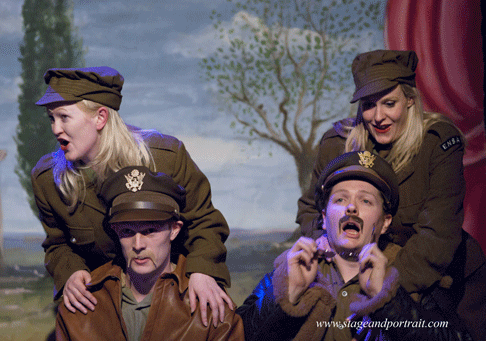 (Left to right) Sarah Denbee (Dorabella), Henry Manning (Guglielmo), Zachary Devin (Ferrando), and Maud Millar (Fiordiligi)
(Left to right) Sarah Denbee (Dorabella), Henry Manning (Guglielmo), Zachary Devin (Ferrando), and Maud Millar (Fiordiligi)
The production utilizes an English translation by Martin Fitzpatrick, tweaked here and there to reference the 1940s situation. It is beautifully idiomatic and faithful to the music’s rhythms; this, in combination with the clear articulation of the singers, made it remarkably easy to hear almost every word. And it was worth paying attention, for line after line had the audience indulging not just in polite chortles but unrestrained hilarity. Two examples from Despina: “What do you think your lovers will do on ‘active service’?”; “Eat up the pasta, but leave room for the salami!” Examples of sensitive modernizing include Ferrando and Guglielmo telling Don Alfonso “You’re a bitter old cynic. / You should be in a clinic” and “I think we’ll hit the jackpot.” One line which caught everyone’s attention was Guglielmo’s describing Fiordiligi as a “faithless, double-crossing, deceitful, lying bitch!” While Italian “cagna” does translate as “bitch,” in the original it is merely the last in a string of nouns, some of them rather past their sell-by date. The piling up of adjectives in the English made the b-word far more emphatic; the fact that it seemed more likely to be spoken by Guglielmo’s assumed American character made the rhetorical moment a memorable coup de théâtre.
The thoroughly entertaining and easily accessible dialogue, the irresistible buffoonery surrounding the “American” imposture, the well-judged, hammy performances by the sisters, who gave the general impression of feeling lucky that they had men at all, let alone two each, and the bounce and verve which Hampstead Garden Opera brought to the whole performance, made it difficult to remember that Mozartean opera is often disparaged as an elitist pastime even by people who like Shakespeare, or who will queue in the rain for a Leonardo da Vinci exhibition. There was nothing elitist about this production. It was popular Mozart, but not dumbed down Mozart, and in fact more intellectually engaging than many a “classic” production in the original language. (When he directed a landmark Magic Flute in English in 1911, Edward Dent argued that there were no limits to the potential popularity of Mozartean opera in Britain, provided it were performed in good translations — I’m now convinced he was right.) A glance around the utterly unpretentious Upstairs at the Gatehouse theatre revealed a very diverse audience of the young and old, fashionable and unfashionable, and (I would guess) very different income levels. A deep and unforced sense of pleasure appeared to be general.
In productions like this, put together on shoestring budgets, goodwill and enthusiasm, it is of course unreasonable to expect the very highest musical standards. But that acknowledged, the level was remarkably high, and one would have needed a fastidious ear or uncompromising “professional” standard to go home feeling unsatisfied. The six principals were all outstanding, and if their singing tended to the robust rather than the subtle, this fitted the generally spirited nature of the production. They all possessed a strong stage presence, displayed fine acting skills, and brought an infectious zest to everything they did.
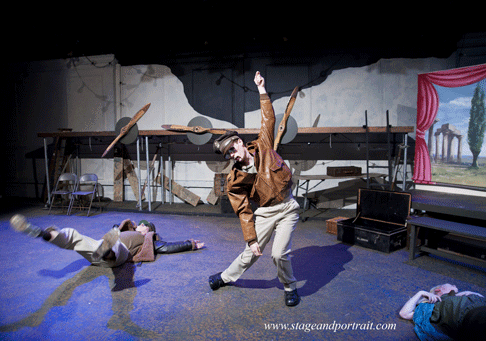 Zachary Devin (Ferrando), Henry Manning (Guglielmo, and Sarah Denbee (Dorabella)
Zachary Devin (Ferrando), Henry Manning (Guglielmo, and Sarah Denbee (Dorabella)
The musical director was Dorian Komanoff Bandy, who has undertaken extensive research into historical performance practices in Mozart’s operas and brings the results to this particular production. I can do no better than quote his own account: “In our production of Così, we see the musical text not as a finished document, but as a starting point. True to 18th-century practices, cadenzas will be fitted to the individual singers, and will vary with each performance. Ornamentation will likewise be mostly unpremeditated. Even my recitative continuo, which I will play on a fortepiano similar to Mozart’s, will be active and pervasive, participating in the dramatic action rather than accompanying it. (Would Mozart, the great showman, have sat idly at the keyboard and strummed chords only at cadences?)” I am not qualified to comment on the historical claims made here, but there was no arguing with the fact that the approach brought the music to life in a way which suited the production perfectly. Komanoff Bandy’s palpable passion for what he was doing matched that of the principals on stage, and he secured some very fine playing from his little orchestra. Tempos were fast, but not excessively so, and the music bristled with energy, conveying a general sense of urgency and agitation appropriate to the unstable wartime scenario. This was not the “Classical” or even the “Romantic” Mozart, but it was an unquestionably theatrical Mozart.
It is worth adding, in conclusion, that Hampstead Garden Opera, founded in 1990, has always had a special affinity for Mozart. In fact the company was established specifically with a view to performing his operas, and though they have gone on to explore the works of many other composers, they have kept returning to Mozart. But in the past they have focused mainly on Don Giovanni, Figaro, and The Magic Flute. This is only the second time they have presented Così fan tutte, making it all the more praiseworthy that they have pulled off such a bold and successful reinterpretation.
David Chandler
Cast
image=http://www.operatoday.com/Cosi_HGO_Poster.gif image_description=Così Fan Tutte, Hampstead Garden Opera product=yes product_title=W. A. Mozart: Così Fan Tutte product_by=Ferrando: Zachary Devin; Guglielmo: Henry Manning; Fiordiligi: Maud Millar; Dorabella: Sarah Denbee; Despina: Marion Wyllie; Don Alfonso: Daniel Roddick. Hampstead Garden Opera. Conductor: Dorian Komanoff Bandy. Production Director: Daisy Evans. Artistic Director: Oliver-John Ruthven. Set and Costume Designer: Katherine Heath. Upstairs at the Gatehouse, Highgate, London, 3 May 2012. product_id=Photos by Laurent Compagnon courtesy of Hampstead Garden OperaMore Casting Changes at Bayreuth
By Frank Cadenhead [Opera Today, 9 May 2012]
Casting changes continue at the Bayreuth Festival, now only three months away. Tenor Lars Clevemann, who sang the title role of Tannhäuser last year, has withdrawn from the role this year. “This was at his own request” explains Festival spokesman Peter Emmerich. He will be replaced by Torsten Kerl.
Torsten Kerl to Perform Tannhäuser
Tenor Lars Clevemann, who sang the title role of Tannhäuser last year, has withdrawn from the role this year. “This was at his own request” explains Festival spokesman Peter Emmerich. He will be replaced by Torsten Kerl.
Kerl is not new to Bayreuth, having sung Balthasar Zorn in Die Meistersinger von Nürnberg from 1996 to 2000 in the then-new production by Wolfgang Wagner and was in the cast of The Flying Dutchman in 1998 to 1999.
The controversial Tannhäuser production, by director Sebastian Baumgarten, was greeted by a chorus of boos at the opening last year. In a recent interview, Festival co-director Katharina Wagner acknowledged that the staging needs to be “further developed.”
Frank Cadenhead
image=http://www.operatoday.com/Torsten_Kerl.gif image_description=Torsten Kerl [Photo copyright Bettina Stöß] product=yes product_title=Torsten Kerl to Perform Tannhäuser product_by=By Frank Cadenhead product_id=Above: Torsten Kerl [Photo © Bettina Stöß]Philip Glass: Einstein on the Beach, Barbican, London
Members of the audience are invited to come and go as they please (and some went and didn’t then come back, arguably with some justification). The programme for the event is high-class in itself, lavishly illustrated and includes the libretto, itself remarkably succinct, and a host of other information. None of which helps, really.
The booklet is adorned by a single shaft of white light against a black background— actually from the segment ‘Bed’, in which the shaft moves ever so slowly (tortuously, one might say) towards and upright position before it ascends. All very symbolic— but of what?. The answer is to drop the search for meaning and enjoy the ride and, as a sequence of beautifully executed dances (there is far more dancing than singing) and comedic soap operas (the Trial Scenes, in which one character bore a spooky resemblance to Margaret Thatcher), it works a lot better. Or rather it works differently, for to drop the search for meaning means either to let it all wash over you, or to open a gateway to the subconscious. Injecting Glass into your brain in that way (pardon the pun) might work for some (and probably worked a whole lot better thirty-odd years ago), but alas these days it all comes out as rather dated.
And that sequence of whats— of what?, in what?, to what?— is one that hovers over the entire evening, culminating, at least immediately, in a huge ‘so what?’. Glass’ music rarely moves the listener, except to induce a state of trance, perhaps. So at the end of this sequence of scenes (narrative trajectory really isn’t the point here)— one leaves the Barbican Theatre in a state of some frustration. Just like when you can’t sleep but you know you’re achingly tired. That sort of frustration.
Glass worked with Robert Wilson to produce this minimalist behemoth, taking a series of drawings by Wilson and adding his own characteristic music. There is a sort of willful obfuscation that runs through the piece, and Glass and Wilson seem to make this explicit through the image of a clock running backwards— here, truly, nothing is as it seems.
That it was even longer than it should have been only added to the problems. There was a hiatus (I don’t really want to call it an interval) of what was promised to be ten minutes and ended up being some twenty. This was to fix a succession of glitches that had affected the production, from bits of set really not being where they should be to stage hands with torches in full visibility wondering around, looking as baffled as the audience probably was about the production anyway. It was Wilson himself that came out to apologise— and also to tell us that figures in the final scene wouldn’t be flying around as originally intended.
The standard of performance was remarkably high, as one would perhaps expect from Glass specialists. Antoine Silverman, as Einstein, was jaw-droppingly good. Dressed as Einstein and sitting on the corner of the stage, his violinistic pyrotechnics were magnificent. One shudders to think how long it must have taken to learn Glass’ horribly fast repetitions— one also has to ask was it worth it though. The scenes which were good, were good— the Knee Plays (Helga Davis and Kate Moran) were dispatched with a superb sense of fascinating detachment. The chorus, too, was exemplary, as were the seasoned instrumentalists. But it was the dancers that impressed most— it was impossible to take one’s eyes off them, whether whirling around the stage like dervishes or in stylized movement that evoked Noh theatre.
Einstein on the Beach is the first of three operas Glass wrote on historical figures (the other two are Akhnaten— memorably staged in the 1980s by ENO and centering on the Pharoah who introduced monotheism a long time before Christians jumped on the bandwagon— and Satyagraha, based on the life and teaching of Gandhi). In fairness, some of the excitement of this novelly-constructed work came through, but that was duet to the excellence of performance and dancing. And Glass still has the ability to refract time— in an analogous way to Wagner, for in both cases we experience time differently, yet in a different way (in Glass through mesmeric repetition rather than via Wagnerian extended harmonic plateaux). Try the Entrance Music for Trial 1 to see what I mean.
And yet, and yet … as I write some three days on from the evening of performance, there is the niggling feeling that, despite its shortcomings and frustrations, Einstein on the Beach has affected me ins some deep but as yet unlabelled way. Yes, it sounds like Glass should, but it also has a sound-aura all of its own. Images of the Trial Scenes, with their cutesy comedy, reappear and resonate. The impeccable dancers continue to cast a spell. Hence the frustration of the end of the experience slowly transforming itself over the course of the past few days. I’m not sure I’d like to hear it again in the near future, though. Perhaps in another thirty years?
Colin Clarke
image=http://www.operatoday.com/Einstein_1921_portrait.gif image_description=Albert Einstein, 1921 [Source: Wikepedia] product=yes product_title=Philip Glass : Einstein on the Beach product_by=Einstein / Solo Violinist: Antoine Silverman; Featured Performer: Helga Davis; Featured Performer: Kate Moran; Boy: Jasper Newell; Mr Johnson: Charles Williams. Philip Glass Ensemble. Conductor: Michael Riesman. Director: Robert Wilson. Choreography: Lucinda Childs. Barbican Theatre, London, Friday, May 4th 2012. product_id=Above: Albert Einstein, 1921 [Source: Wikipedia]May 7, 2012
The Barber of Seville, San Diego
In 2011 it was performed 440 times in 79 cities, a fact that would have pleased French writer Stendhal, author of a fascinating, though alas, inaccurate “biography” of Rossini. Charmed as Stendhal was by the “whipped cream and fanfaronades” of Rossini’s operas, he is said to have worried about what would happen to The Barber when it was as old as Don Giovanni.
But there we were, nearly two hundred years later, sitting in the San Diego Civic Center, still being charmed by Rossini’s “whipped cream and fanfaronades”, though now decked out with twenty-first century gags, pranks, and production techniques. The San Diego production, created by John Copley in1989 for the Lyric Opera of Chicago, was a stylishly directed and delightfully performed production that lived up to the opera’s reputation. Its setting, about which more later, was inspired by Belgian surrealist René Magritte.
This was an excellently selected cast with experienced Rossini stylists and three singers new to San Diego. Milan born conductor, Antonello Allemandi, debuting with the company, led the orchestra in a joyously fleet performance of the overture. Rossini tenor John Osborn, a veteran of countless (quel pun!) Almavivas, who recently scored a success in title role of Rossini’s Otello, sang his first scene “Ecco ridente” with clarity and lovely phrasing — though unfortunately, amidst a sinister looking crew of black-cloaked musicians. The appearance of Lucas Meachem making his San Diego debut as Figaro, however, sent sparks flying. There’s no doubt that any one who portrays Figaro, the protagonist of Beaumarchais’ three plays (all made into operas) in which he must rescue Count Almaviva and Rosina, has got to be a commanding presence. It is likely that Beaumarchais, a commoner, who hobnobbed with French royalty (he had dealings with both Louis XV and XVI) modeled Figaro on himself. Figaro may have been factotum to all of Seville, but Beaumarchais was factotum to all of France. Born Pierre-Augustin Caron, the son of a watchmaker — he gave himself the “de Beaumarchais” title somewhere along the line — his escapades were far more world shaking than those of Figaro. Among other things, he was involved in a secret French mission which smuggled arms to American revolutionary forces. San Diego Opera’s factotum, baritone Lucas Meachem, who was debuting with the company, fit the bill. A large man, who dwarfed the cast, he easily “Figaroed” his way into the audience’s heart in a production that had him sliding down to his shop on a brass pole.
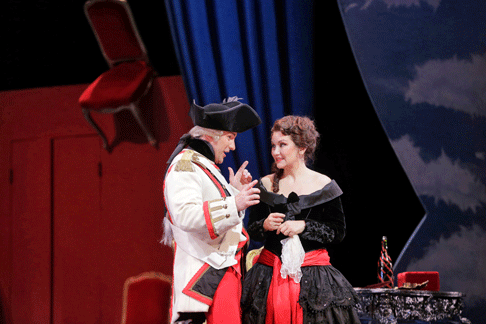 John Osborn as Count Almaviva and Silvia Tro Santafé as Rosina
John Osborn as Count Almaviva and Silvia Tro Santafé as Rosina
Spanish mezzo soprano Silvia Tro Santafé, also making her San Diego debut, was a charming Rosina, whose darkly colored voice had all the coloratura and trills that go with the role. Fellow Spaniard, bass, Carlos Chausson, a veteran of more than 200 performances of The Barber of Seville, portrayed her guardian. Though Chausson sang with gusto, as the slimmest, spriest Dr. Bartolo I’ve ever seen, he brought a different view of the character. The production also marked the San Diego debut of Alexander Vinogradov. The thirty-six year old Russian bass, who made his Bolshoi debut when he was twenty one, made a perfectly dour looking Don Basilio and sang his great “calumnia” aria with aplomb and style. Mezzo soprano, Suzanna Guzmán, as Bartolo’s housekeeper, portrayed a mellower Berta than most.
As to the Magritte inspired production — the best that can be said of it, is that it was irrelevant. It added nothing to the opera, but fortunately, took nothing away. Plump little white Magritte clouds motionless on blue skies, were imprinted on the backdrop and on Almaviva’s and Rosina’s blue final scene wedding clothes. The clouds were also fixed on the peach colored walls of Figaro’s shop. There was lots of red in costumes and furnishings, lots of furniture askew. There were floating chairs, oddly placed derby hats, and the storm interlude featured folks rushing back and forth with windblown umbrellas, as if Rossini, master of storm music, wasn’t telling you that already.
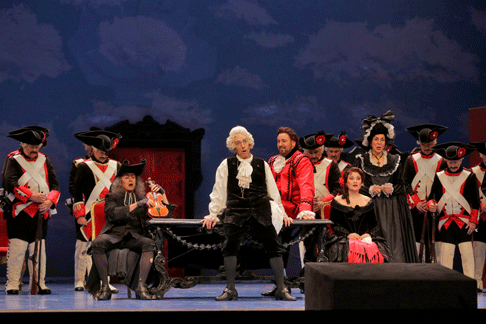 The cast of The Barber of Seville
The cast of The Barber of Seville
The final scene in this production included the Count’s “Cessa di più resistere”, a difficult aria that Rossini, famous for his musical recyclings, reset as “Non più mesta” for the contralto heroine of his next opera, La Cenerentola (Cinderella). “Cessa di più resistere” has only recently been restored to The Barber of Seville with the arrival on the operatic scene of young tenors able to handle its fiendishly difficult fioratura. John Osborn is one of them, though there was a certain dryness in his voice late in the opera at the performance I attended.
I’ve often wondered what gives The Barber of Seville its appeal. Its love story? Boy and girl are manifestly fated to be together. Two actsful of complications keep them apart. Then in act three, problems are resolved, and the lovers (and audience) go home believing in “happy ever after”? Even if you throw in a prince, that can’t be what makes me want to see it again and again. That it’s revolutionary? Demonstrates that a clever, unschooled barber can solve problems that a wealthy, cultured aristocrat cannot? Sure, in its 1775 French theatrical version. Not for free old me in San Diego in 2012. That it’s a humanistic tale? Inveighs against social injustice, and portrays flawed, complex characters with whom each of us can identify? Possibly.
All these theories have been advanced, and likely others I haven’t yet heard of. But I think it’s simpler than all that. Lazy, melody-laden Rossini with his gift for musical humor threw together the right pieces of music for Beaumarchais’ brilliantly funny, humanistic, revolutionary, love story, and created a work, not only (as Stendhal feared) right for his own time, but for…well, for two hundred years, anyway.
Estelle Gilson
image=http://www.operatoday.com/BARB0264.gif image_description=Lucas Meachem as Figaro [Photo by Ken Howard courtesy of the San Diego Opera] product=yes product_title=Gioachino Rossini: The Barber of Seville product_by=Count Almaviva: John Osborn; Figaro: Lucas Meachem; Rosina: Silvia Tro Santafé; Dr. Bartolo: Carlos Chausson; Don Basilio: Alexander Vinogradov; Berta: Suzanna Guzmán. Conductor: Antonello Allemandi. Director: Herbert Kellner. Scenic Director:John Conklin. Costume Designer:Michael Stennett. product_id=Above: Lucas Meachem as FigaroPhotos by Ken Howard courtesy of the San Diego Opera
May 2, 2012
The Kathleen Ferrier Awards 2012
First held in 1956, following Ferrier’s tragically early death on 22 April 1952, the competition has supported many young singers in their early years of training and, since 2009, has also offered additional support to its prize winners in the form of sponsoring a series of recitals around the UK, giving these singers public platforms to develop their recital skills. Recent prize recipients have included Emma Bell, Kate Royal, Elizabeth Watts, Martene Grimson, Andrew Kennedy and Robert Murray, and many others who have gone on to win considerable international acclaim.
The demands of the competition are rigorous: both first round and semi-final must include an operatic aria and art song, and singers must show appreciation of the musical and technical characteristics of different periods and styles. The final must contain at least one song in English and present a balance between opera and song.
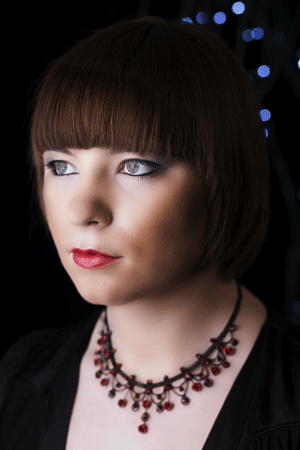 Natalya Romaniw [Photo by Patrick Allen, Opera Omnia, courtesy of Hazard Chase Limited]
Natalya Romaniw [Photo by Patrick Allen, Opera Omnia, courtesy of Hazard Chase Limited]
This year’s winner, Welsh soprano Natalya Romaniw, offered a daring programme which played to her strengths — a big, richly coloured tone and a confident, mature dramatic presence. Opening with Tchaikovsky’s ‘Atchevo eta pryezhdye nye znala’ from Iolanta she exhibited a beautiful vocal lustre and a natural instinct for phrase shape, carefully modulating the dynamic expression to communicate textual meaning. Strauss’s ‘Ständchen’ showed off the glistening, exhilarating sheen of her upper notes, and its power, while the same composer’s ‘Ruhe meine seele’ demonstrated that Romaniw can sustain a centred, pleasing line in the lower register too. Jonathan Dove’s ‘Between your sheets’ was imaginative and adventurous programming, and here Romaniw adopted a more intimate tone, sensitively conveying the words. But, it was back into extrovert mode for Britten’s ‘Tell me the Truth about Love’: fortunately, she did not indulge in cabaret hyperbole, but enjoyed sharing the wit and humour of the song with the audience, in an appealing, engaging rendition which deservedly garnered the song prize for Romaniw too.
Baritone Ben McAteer and soprano Ruth Jenkins shared second prize. I felt that McAteer’s communication of the text, as he effortlessly embodied a range of characters in different dramatic and emotional situations, put him in the running for first prize. Whether outpouring Romantic angst or relishing the ironic wit of Classicism, every word was crystal clear and every musical gesture perfectly matched to the sentiments of the text. The gradation of dramatic moods in Schumann’s ‘Belsazar’ was superb, the phrase endings beautifully crafted, while ‘Kogda bï zhizn domashnim krugom’ from Eugene Onegin demonstrated the relaxed flexibility of McAteer’s warm baritone. Hamilton Harty’s setting of the traditional Irish song, ‘My Lagan Love’, made a moving conclusion to his programme; the tempo was audaciously slow, McAteer’s dark pianissimo deeply expressive, and the rhetorical power of the song instinctively conveyed.
Ruth Jenkins demonstrated variety of tone and a broad tessitura in an interesting programme which embraced Schubert, Wolf, Handel, James Macmillan and the Icelandic composer, Sigfús Einarsson. Seeming a little nervous at the start, Jenkins struggled to control her vibrato in the long sustained notes that open Schubert’s ‘Litanei auf das Fest Aller Seelen’, but she did show that she knows how to build through individual phrases to shape coherent larger structures. Her intonation settled, however, and Einarsson’s ‘Draumalandio’ was notable for its wistful, gentle ambience. Gaining confidence, Jenkins brought a translucent quality to the tranquil rocking intervals of Macmillan’s ‘The Children’. She skilfully controlled the repetitive vocal line, which, like a child’s song, employs only a few basic intervals, tenderly conveying the innocence of the child in contrast to the more sophisticated gestures of the sparse piano accompaniment.
There were three other finalists. Soprano Eleanor Dennis demonstrated plenty of sparkle in ‘Come Scoglio’ and a burnished lower range in Britten’s ‘Nocturne’ from On This Island. She blended folky gestures with virtuosity in Eva Dell’Acqua’s ‘Villanelle’ but, while this was an accurately performed programme Dennis, in the difficult ‘opening slot’, did not always have the stage presence to fully engage the audience. Dennis’s accompanist, Craig White, was awarded the accompanist’s prize.
The same lack of stage impact also characterised soprano Robyn Allegra Parton’s performance. Although her rendering of Quilter’s ‘Love’s Philosophy’ was exuberant, and ‘My heart leaps up’ from Britten’s Albert Herring carefully shaped, Parton’s performance was accurate, poised and pleasing rather than exciting and impactful.
The limitations of the countertenor repertoire inevitably affected Russell Harcourt’s programming; but while he attempted to introduce variety, juxtaposing Handel with Heggie, Harcourt’s light graceful voice ultimately lacked diversity of colour. This proved problematic in Bach’s renowned ‘Erbarme dich’ from the St. Matthew Passion, where he was unable to impose his presence in the strophic repetitions, following the long piano ‘between-verse’ passages. A burgeoning theatricality was evident in Handel’s ‘Vivi tiranno’ from Rodelinda, however, as well as superb breath control and an effective rhetorical style.
I’m sure we will be hearing much more from all these accomplished singers in future. And, the centenary celebrations continue at the Wigmore Hall on 28 June, when six recent winners — singers Sarah-Jane Brandon, Anna Stéphany, Ben Johnson, Jonathan McGovern, and pianists James Baillieu and John Read — come together to perform a programme of songs, duets and ensembles from Kathleen Ferrier’s repertoire, devised by Graham Johnson.
Claire Seymour
image=http://www.operatoday.com/Kathleen_Ferrier.gif image_description=Kathleen Ferrier product=yes product_title=The Kathleen Ferrier Awards 2012 product_by=Wigmore Hall, London Friday 27 April 2012 product_id=Above: Kathleen FerrierMay 1, 2012
Daughter of the Regiment, Manitoba Opera
In a show that had audience members shrieking with laughter and giving prolonged standing ovations, the all Canadian cast made us proudly patriotic. Director Ann Hodges showed a singular touch for comedy in this impressive mounting.
Front and centre was rising star soprano and Winnipeg native Nikki Einfeld as Marie, the title character. Each time we hear Einfeld her instrument seems to have become more refined. Trim and petite in her becoming military outfit, she was enchanting as the rough and tumble young woman raised by 23 “fathers” — soldiers of the 21st Regiment of the Grenadiers. In contrast to her tomboyish demeanour, her voice was pure feminine lightness, possessing a subtle buoyancy that while not overpowering, had underlying strength and confidence. This was ideally suited to the spunky Marie, as she arm-wrestled baritone Theodore Baerg, playing Sergeant Sulpice. Her scene in the castle, in which she struggles to figure out how to put on a fashionable hat, was a scream.
The story takes place in the early 1800s, in the Swiss Tyrolean Mountains. Set designer Beni Montressor (set and props provided by Edmonton Opera) has put together an interestingly rustic and colourful presentation that looks hand-drawn. Creative lighting by Bill Williams brought the best out of this quite simple set.
While the work is sung in French with English surtitles, the English dialogue enabled the audience to get more involved. Canadian actress Fiona Reid, best known for her role as Al Waxman’s ever-patient wife on King of Kensington was a late replacement for ailing comedienne Mary Walsh. Reid, as the Duchess of Krackenthorp, had us in stitches in what amounted to a stand-up routine full of hysterical cracks about Winnipeg and Canadian politicians. From our rapid transit system to Mayor Katz to the controversial water park project and new Ikea, Reid poked fun at our city to the crowd’s delight.
The entire ensemble was strong, with tenor John Tessier a most romantic Tonio, Marie’s love interest. Tessier has a lovely, limpid voice that carries extremely well. With its warm timbre, he seems to float to the highest notes, as in the famous aria “A mes amis,” in which he reeled off a whopping nine high Cs, completely free of strain. Best of all was the chemistry between the two lovers. Marie, desolate at having to leave the regiment to live with her new-found aunt, the Marquise of Berkenfeld, exhibited abundant control in her silkily crafted phrases, soaked in sadness. In “Qui! Vous m’aimez?,” Tonio expressed his love for Marie so sweetly, it was all she could do to resist. The passion was palpable.
Mezzo soprano Rebecca Hass was delightfully haughty as the Marquise, showing great comic style. Fancying herself an attractive target for the French soldiers, she preened and criticized in “Pour une femme de mon nom” in clear and true voice. David Playfair played her nattily dressed butler, Hortensius with superb physical humour and panache.
Baerg’s fatherly Sulpice was one of the strongest showings of the evening. In colourful uniform, (wardrobe by Malabar Ltd. Toronto) he cut a dashing figure with his silvery hair. And then there was his voice — a voice that warms the cockles of your heart with its richness and commitment. Baerg threw himself whole-heartedly into the role of Marie’s protector.
The Manitoba Opera Chorus was kept busy: practically every scene demanded their presence. They were wonderful — dressed to the nines, with convincing acting and full-bodied singing. As Marie’s many fathers, the soldiers’ doting was especially appealing.
As always, the Winnipeg Symphony Orchestra helped make this production special. From the opening plaintive horn call to the final triumphant note of “Salut à la France,” conductor Tadeusz Biernacki milked every melody to its fullest. Special mention must be offered for the touching cello line in Marie’s aria, “C’en est donc fait” that set the scene so beautifully.
Gwenda Nemerofsky
image=http://www.operatoday.com/gaetano-donizetti.gif image_description=Gaetano Donizetti product=yes product_title=Gaetano Donizetti: The Daughter of the Regiment product_by=Click here for cast and other production information. product_id=Above: Gaetano DonizettiDer fliegende Holländer, ENO
There is much to enjoy musically, though there are a few problems too, but Jonathan Kent’s production fails to cohere. Whilst resemblances to Tim Albery’s dreary production across town for the Royal Opera are doubtless coincidental — though might it not reasonably be part of a stage director’s job to inform himself of what others in his position have done? — the factory setting of the second act, the increasingly odd, yet unrevealingly odd, costumes, and apparent unwillingness or inability to listen to Wagner’s score present an unfortunate kinship.
Unlike Albery, Kent appears to have some ideas. The problem is more that they rarely seem properly thought through, and that they do not necessarily cohere with each other. Video now seems more or less obligatory for the Overture; it is very well done here, but is it really necessary to evoke storms visually when Wagner does pretty well for himself with the orchestra. The curtain comes up a little way in, to present a little girl, a young Senta, one presumes, reading a book, referring to the Flying Dutchman, one presumes, whilst apparently being pushed aside by her busy father. (Weird lighting made the girl appear, at least from my seat, as if she were auditioning for The Black and White Minstrel Show. I wondered what on earth was going to happen, feeling quite filled with foreboding, until I realised that she had not after all blacked up.) The timing is unclear; sometimes we appear to be vaguely contemporary, at other points a few years back, though certainly not when Wagner sets his drama. It seems that Senta therefore imagines her Dutchman from her childhood fantasies; the problem here is that in no way is this as coherently presented as when Harry Kupfer in Bayreuth and Berlin unforgettably presented the drama as her dream. Is she dreaming the rest of the drama? It does not appear so. In which case, how is it that anyone else can see the Dutchman? Most do not — a ghost, perhaps? — but Daland certainly does. How, otherwise, can he treat with this strangely nineteenth-century apparition. A more Romantic, dangerous figure might make more sense; this Dutchman, however, dresses more like a character from Jane Austen. He stands out, but not necessarily in the right way; the concept either does not work or is not adhered to consistently.
A potentially good idea is the viciousness of the other factory workers towards Senta. She clearly does not fit in; they mock her, make her miserable. She belongs somewhere else: Wagner would surely have agreed. This continues into the third act, but alas, an apparent wish to be ‘theatrical’ undermines what might truly have intrigued and provoked. Albery too had a tawdry vision of the crew’s celebrations. Having married — or imagined marrying — the Dutchman during the entr’acte, Senta now finds herself jeered at, molested, and seemingly worse (shades perhaps of David McVicar’s ‘Dance of the Seven Veils’, in which Salome’s childhood abuse is relived). The women of the community do not care; they aid and abet the events. Unfortunately, the presentation is so over the top that it becomes more ludicrous than threatening, more West End musical or perhaps television game show than serious music drama. (And The Flying Dutchman is nothing if it is not taken seriously.) Amongst the oddities we witness are a person dressed up as a parrot, lots of inflatable toys, some people with Santa Claus hats, at least one woman with a huge red hand, and a few supernumeraries whose principal function seems to be to look good when they take off their shirts. It all seems quite out of proportion to whatever we have seen before, and reeks of a desire for spectacle, of whatever sort. Not once did I have the impression that Kent was responding in any depth to the score; often he did not even respond to the words. The frankly silly dance movements flatly contradicted, yet not in an interesting way, Wagner’s writing.
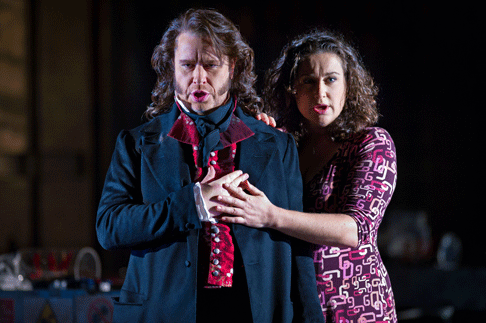 James Creswell as The Dutchman and Orla Boylan as Senta
James Creswell as The Dutchman and Orla Boylan as Senta
Senta is then rescued by the re-appearance of the Dutchman’s crew — unfortunately rendered in amplified, recorded form: a terrible mistake — but how and why, if, and I repeat if, they do not really exist? Has she merely imagined everything? In that case, it is difficult to take seriously any claims to societal critique, at least without further guidance or refinement. As for why a spotlight suddenly swung around the theatre and focused upon a seemingly random part of the Coliseum ceiling, I simply have not the faintest idea. My abiding impression of Kent’s production, then, was of an undergraduate with a few too many ideas, who would need to be taken aside, advised to deepen his acquaintance with the work over a few years, before returning to it and deciding more clearly how to pursue one or two of those ideas. The contrast with ENO’s most recent other Wagner, Nikolaus Lehnhoff’s ‘heap of broken images’ Parsifal, is stark.
The ENO Orchestra was on magnificent form, as fine as I can recall hearing it. As for Edward Gardner’s direction, this was a reading clearly determined to focus on dramatic excitement. There is nothing wrong with that, up to a point, but it missed Wagner’s depths. There was little of the problems with maintaining dramatic line that bedevil so many conductors — an impressive achievement for someone conducting his first Wagner opera — but the sound and drive seemed more appropriate to Verdi, or at a push perhaps to Rienzi. As so often, the Overture suffered from being driven too fast to start with and then abruptly altering to a drawn out snail’s pace. Yet once that was over with, and to the extent that one could ignore the lack of ‘German’ depth in sound quality as well as ‘musico-dramatic’ striving towards symphonism, there was a good deal to enjoy. Whether one should be ‘enjoying’ rather than thinking is of course another matter, but it was a relief to be spared the stopping and starting one so often endures, even in high-ranking houses. Perhaps Gardner’s conception will deepen over time. The work was performed without an interval, without the later, ‘redemptive’ halos to the conclusions of the Overture and the third act. I heartily approve, though a highly distinguished Wagner scholar, to whom, as it happens, I had been speaking on the telephone just before heading off to the Coliseum, thought otherwise. (Apparently he had advised Gardner to opt for the more ‘authentic’ version with intervals, on the basis that Wagner never performed it otherwise.)
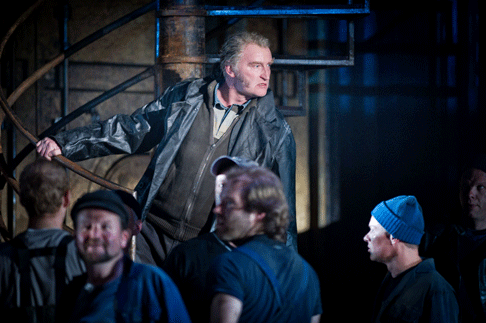 Clive Bayley as Daland
Clive Bayley as Daland
James Creswell made for the most part a commanding Dutchman; his care with the words, here sung in David Pountney’s translation, was noteworthy. Unfortunately, Orla Boylan seemed quite miscast as Senta. It is, I know, a very difficult role, but her often squally tone often turned downright hectoring; at times, it was almost impossible not to wince. Intonation deteriorated as the work progressed too. Thank goodness, then, for a typically detailed character portrayal from Clive Bayley, despite the silly dance he was forced to perform at the end of the second act, and for the undoubted star of proceedings, Stuart Skelton as Erik. His Romantic ardour led one to sympathise as often one does not, yet he ensured that one remained aware of the character’s limitations, of his modest existence, so as to avoid the danger of thinking Senta should have thrown in her lot with him after all. Skelton’s is a fine voice, of course, but he can act too — and certainly did. Though the voices could hardly be more different, I was reminded of a production I saw in Vienna, in which Klaus Florian Vogt — the first time I heard him — quite stole the show. Despite that misguided decision concerning the Dutchman’s crew, the choral singing was, a few rough edges aside, of very high quality: weighty and yet surprisingly incisive. Would that I could say the same concerning the production. For far more interesting stagings, turn on DVD either to Kupfer from Bayreuth or to Martin Kušej’s recent production for the Netherlands Opera.
Mark Berry
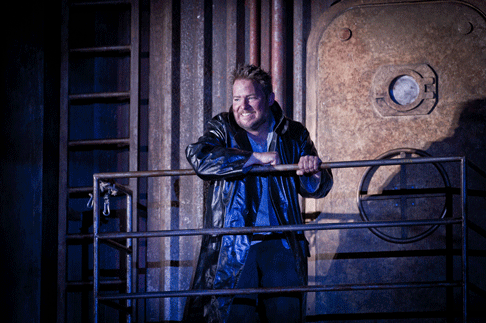 Robert Murray as Daland’s Steerman
Robert Murray as Daland’s Steerman
Photos by Robert Workman courtesy of English National Opera
Two from Florence
They’re alike in some key ways…
- Both operas are set in Florence
- They are roughly contemporary in composition from around 1917-1918
- Both operas have plots driven by avarice and disparities of wealth
Yet even so, …
- Zemlinsky is not well-known, while Puccini is arguably the most popular composer of the 20th Century
- A Florentine Tragedy is dark, while Gianni Schicchi is a comic masterpiece
- Notwithstanding the date of composition, Zemlinsky’s music is often dissonant and disturbing, whereas Puccini’s occasional dissonances are usually zany rather than disturbing, and serve to set up the luscious melodies he spins. But Zemlinsky does offer a few wonderful climaxes.
Conducted by Andrew Davis, I believe this is the largest COC orchestral complement we’ve seen in a long time, at least in the Zemlinsky. Huge as the assembled forces may have been for most of the work, Davis held them delicately in check, swelling only occasionally, particularly at the volcanic conclusion. The Zemlinsky work sounds a lot like Richard Strauss, with the expressionist flair we find from operas such as Elektra or Salome.
Wilson Chin’s set design captured these two very distinct worlds, allowing them to cohere wonderfully as a satisfying evening of opera. The dark work (called a “tragedy” but maybe not so tragic) unfolds as a love triangle on a big bare stage, while the light comedy takes place in a cramped space full of junk. Although they’re different the worlds of both are so preoccupied with property and materialism that it’s manifested in the physical environment of the set.
Bass-baritone Alan Held had a busy night. As Simone in the tragedy he’s singing a great deal, much of it in a high register, followed by the role of Gianni Schicchi, which isn’t much easier, also lying high. The teutonic style of the Zemlinsky seems to be a better fit for Held’s voice than the Italianate comedy, although true to his name he more than held his own.
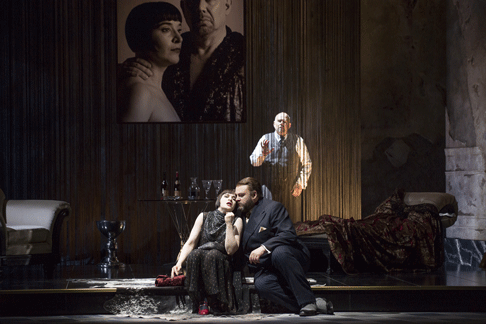 (l - r) Gun-Brit Barkmin as Bianca, Michael König as Guido Bardi and Alan Held as Simone (background) in the Canadian Opera Company production of A Florentine Tragedy, 2012. [Photo by Michael Cooper courtesy of the Canadian Opera Company]
(l - r) Gun-Brit Barkmin as Bianca, Michael König as Guido Bardi and Alan Held as Simone (background) in the Canadian Opera Company production of A Florentine Tragedy, 2012. [Photo by Michael Cooper courtesy of the Canadian Opera Company]
While I laughed throughout the Puccini I enjoyed the dark opera more. For me it’s a brand-new work, full of wonderful moments, luscious orchestral sonorities, unexpected emotional turns, and a wonderful concluding five minutes. Director Catherine Malfitano is to be congratulated for shaping this complex and ambiguous work successfully. Bianca, Simone’s wife, is shown with her husband in an oversize portrait centre stage (you can see it in the photo) with her husband’s hand in a controlling position on her neck. In their first encounter he gently seizes her -if that isn’t a complete oxymoron—by the back of the neck. While this may seem obvious, the story is anything but. Held’s physical presence is threatening even though he is subservient to the Prince, who is busily cuckolding his subject right in Simone’s own home.
Gun-Brit Barkmin makes a wonderfully complex Bianca, surrendering to Michael König’s Prince, yet seemingly in thrall to her husband’s complex dominance. It should be no surprise that this twisted tale comes to us from Oscar Wilde. Malfitano’s conclusion to A Florentine Tragedy provided a wonderful echo of the cloak from one of the original Puccini triptych, namely Il Tabarro ; where the cloak in the Puccini shocker conceals a dead body, in this case the cloak leads to an unexpectedly loving and sensual embrace.
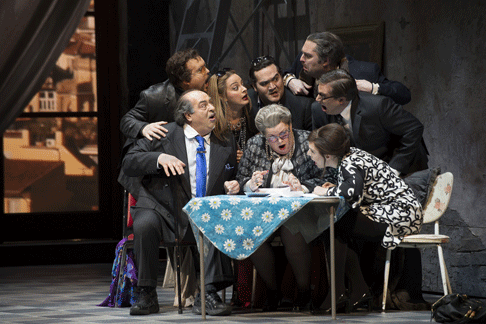 A scene from the Canadian Opera Company production of Gianni Schicchi, 2012. [Photo by Michael Cooper courtesy of the Canadian Opera Company]
A scene from the Canadian Opera Company production of Gianni Schicchi, 2012. [Photo by Michael Cooper courtesy of the Canadian Opera Company]
While I found the Puccini a huge relief after the darkness of Zemlinsky, I wasn’t sure about the updating. Instead of Medieval Florence we get something closer to Jersey Shore: which is apt I suppose considering that Malfitano is both American and Italian. Sometimes the updating was very good, as for instance when René Barbera as Rinuccio sang his big paean to Florence from atop a pile of junk. I worried for his safety -and no this isn’t to be mistaken for Spiderman—with the young tenor perched easily twenty feet above the stage floor. I reminded myself that while the set appeared rickety of course it was carefully constructed to support him. Overall I found that the modernization made the show warm & fuzzy rather than edgy, defusing some of the laughter that the opera can sometimes generate. It’s still lots of fun though and especially delightful after the Zemlinsky.
Barbera’s singing was one of the highlights of the evening, along with the Lauretta of Simone Osborne, singing “Oh mio babbino caro”. I felt Davis was channelling Toscanini, imbuing the operas with wonderful pace & verve, but also sometimes challenging the singers to perhaps sing faster than they might have wished.
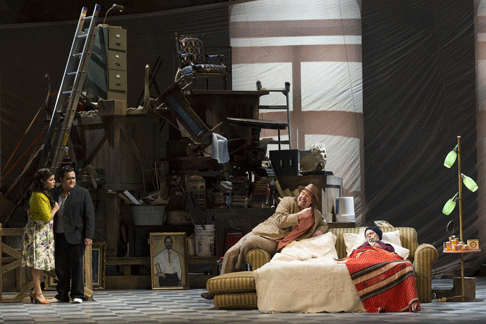 (l - r) Simone Osborne as Lauretta, René Barbera as Rinuccio and Alan Held as Gianni Schicchi in the Canadian Opera Company production of Gianni Schicchi, 2012. [Photo by Michael Cooper courtesy of the Canadian Opera Company]
(l - r) Simone Osborne as Lauretta, René Barbera as Rinuccio and Alan Held as Gianni Schicchi in the Canadian Opera Company production of Gianni Schicchi, 2012. [Photo by Michael Cooper courtesy of the Canadian Opera Company]
Held, Barbera & Osborne make a loveable family unit, in this crowd-pleaser of an opera. I hope no one is scared off by the opera composed by a guy whose name starts with a Z. This double bill deserves to score well with the Toronto audience.
The Canadian Opera Company production of A Florentine Tragedy andGianni Schicchi continue at the Four Seasons Centre in Toronto until May 25th.
Leslie Barcza
This review first appeared at barczablog. It is reprinted with the author’s permission.
image=http://www.operatoday.com/florentine-COC_01.gif image_description=Alan Held as Simone and Gun-Brit Barkmin as Bianca in the Canadian Opera Company production of A Florentine Tragedy Alan Held as Simone and Gun-Brit Barkmin as Bianca in the Canadian Opera Company production of A Florentine Tragedy [Photo by Chris Hutcheson courtesy of the Canadian Opera Company] product=yes product_title=Alexander Zemlinsky: A Florentine Tragedy — Giacomo Puccini: Gianni Schicchi product_by=Click here for cast and other production information. product_id=Above: Alan Held as Simone and Gun-Brit Barkmin as Bianca in the Canadian Opera Company production of A Florentine Tragedy [Photo by Chris Hutcheson courtesy of the Canadian Opera Company]